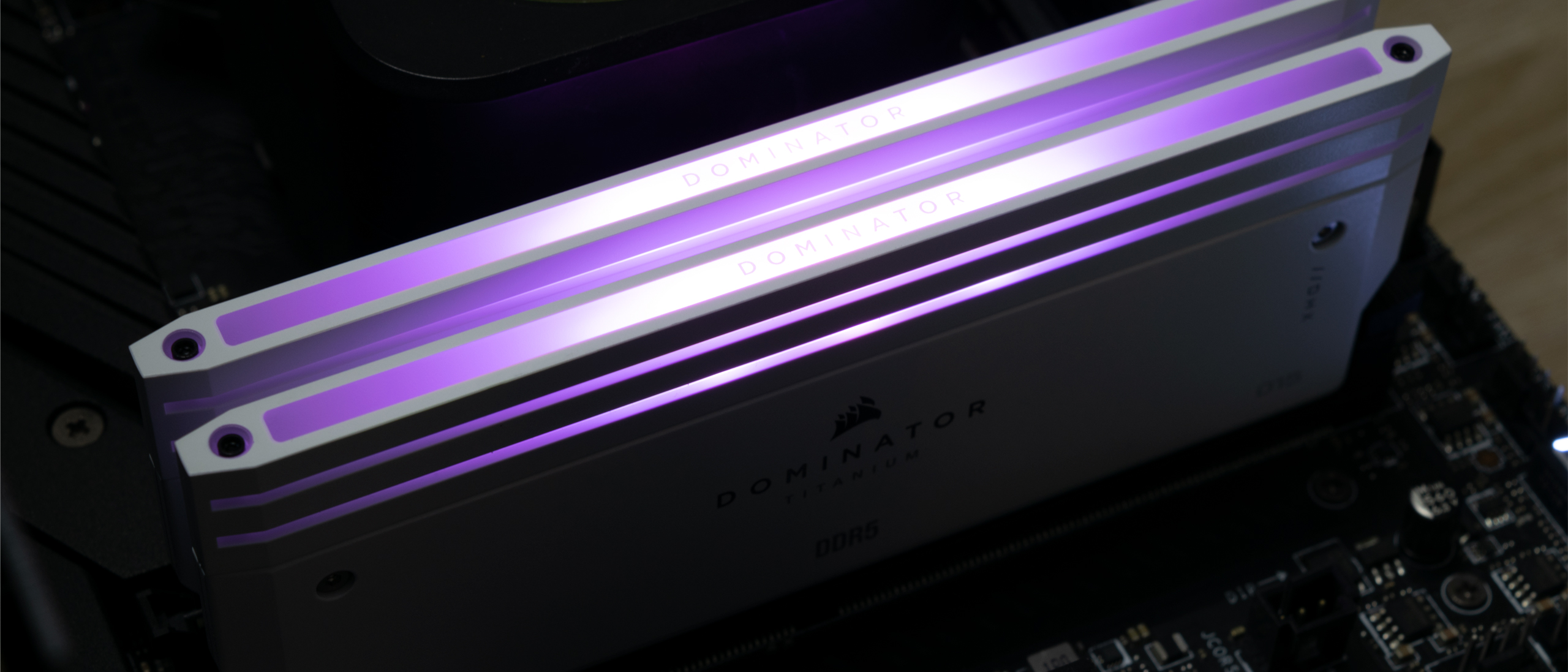Tom's Hardware Verdict
The Dominator Titanium First Edition DDR5-7200 C36 is a high-quality DDR5-7200 memory kit that will satisfy even the most demanding users if they can look past the costly price tag.
Pros
- +
Good performance
- +
Exchangeable top bar design
- +
Overclocked DDR5-7400 profile
Cons
- -
Premium pricing
- -
Expensive fin accessory kit
- -
Requires 1.4V
Why you can trust Tom's Hardware
The Dominator Titanium First Edition DDR5-7200 C36 is one of Corsair's latest memory kits to arrive on the market to compete against the best RAM. DDR5 memory has generated a proliferation of non-standard capacity DIMMs in 24GB and 48GB. The advancements have cleared the way for memory kits with nonexistent densities with DDR4. It brings enormous benefits to consumers through new capacity options and cost savings. Take 48GB (2x24GB) memory kits, like the Dominator Titanium First Edition DDR5-7200 C36, for example, that serve as the halfway point between the 32GB (2x16GB) and 64GB (2x32GB) density. It's an excellent choice for those who want an upgrade from 32GB but don't want to go overkill with 64GB.


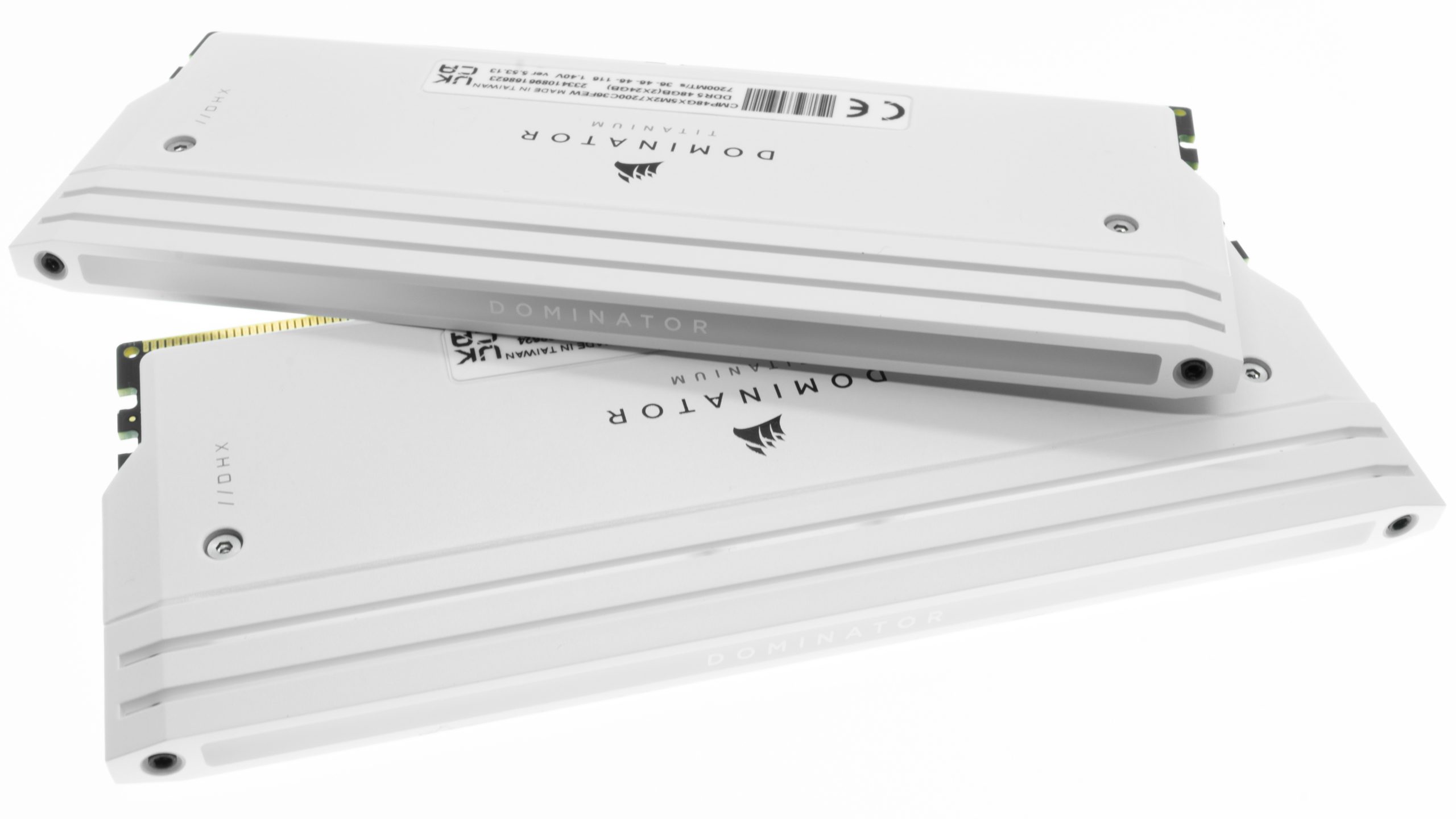
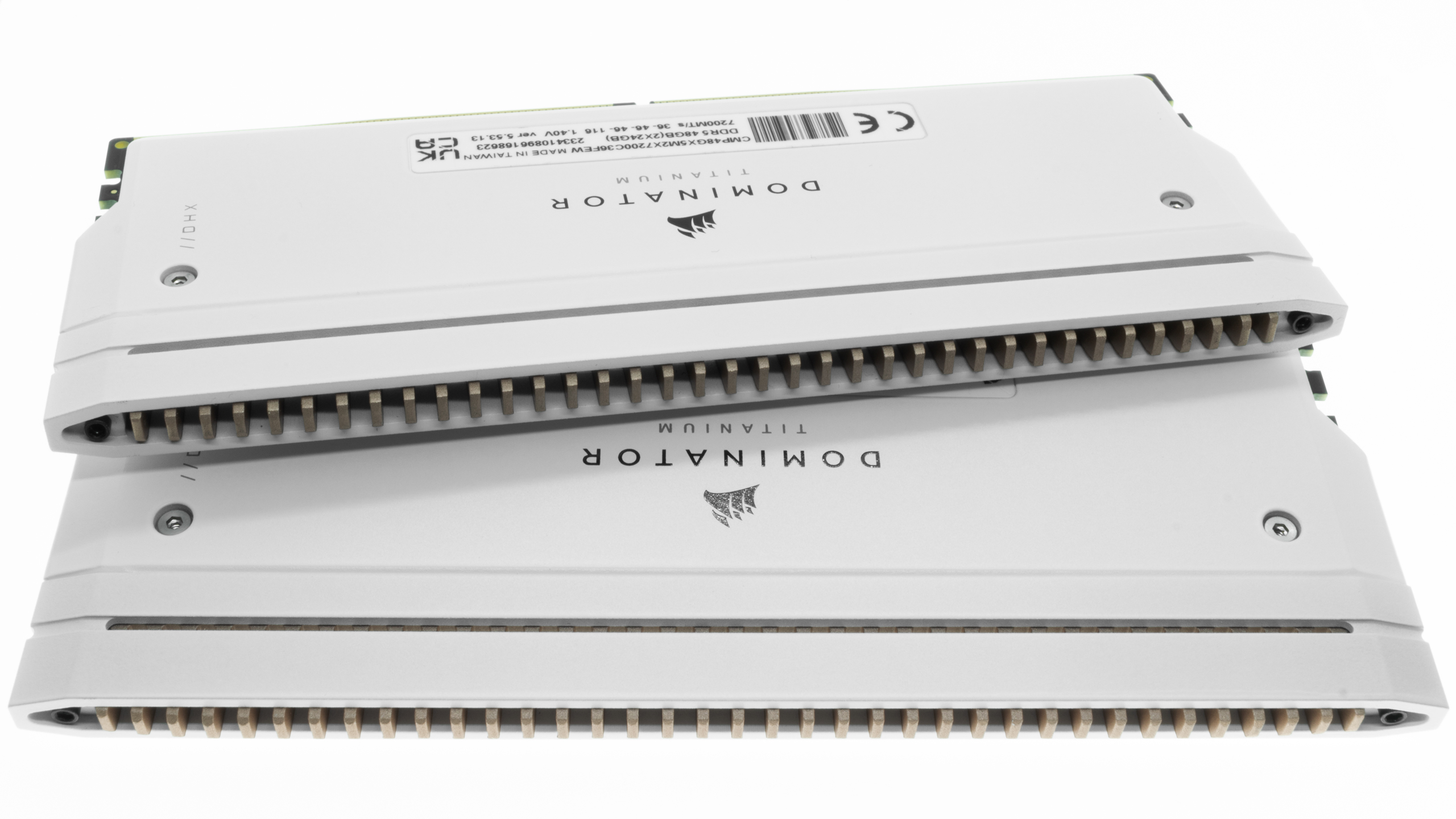
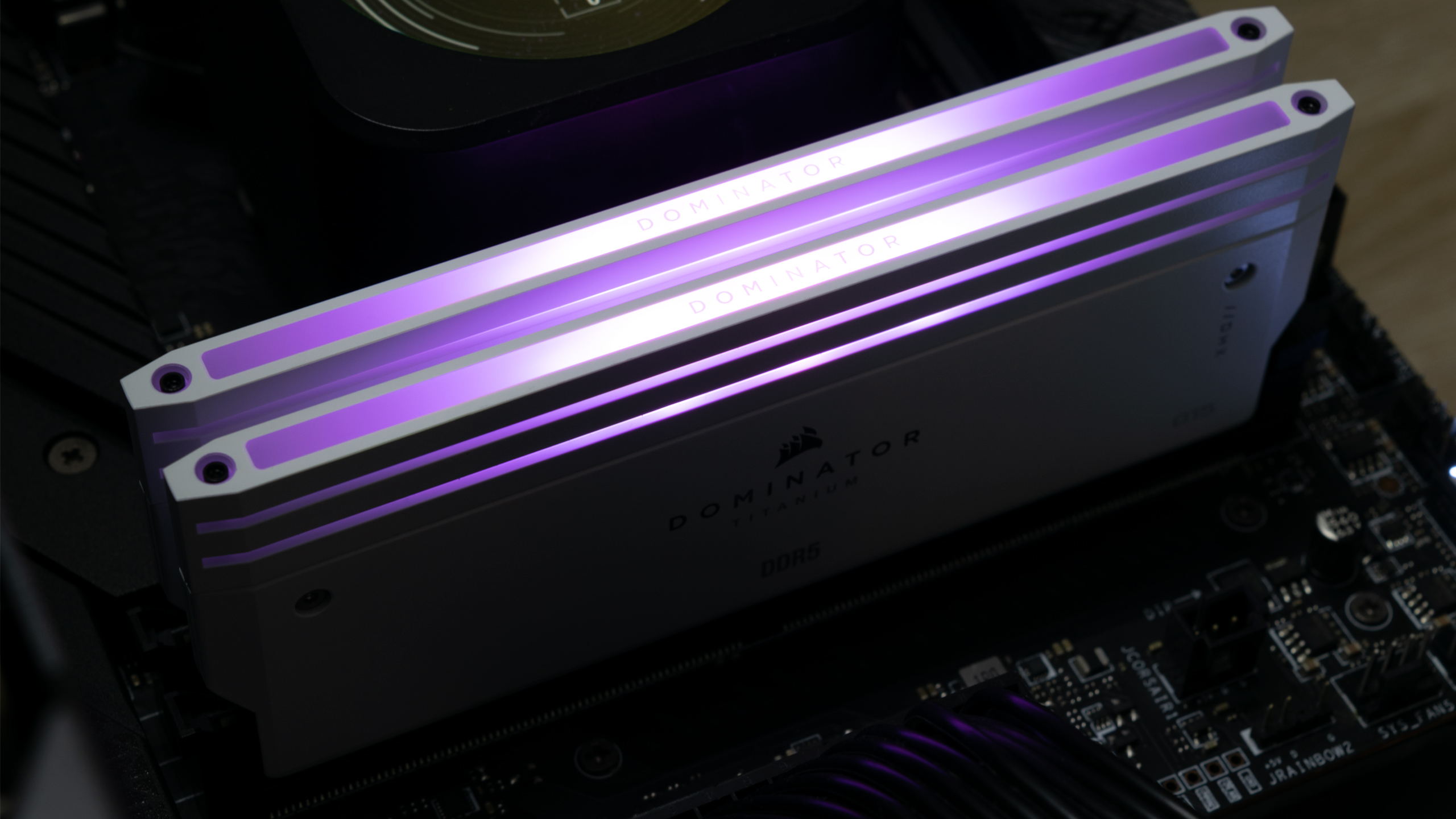
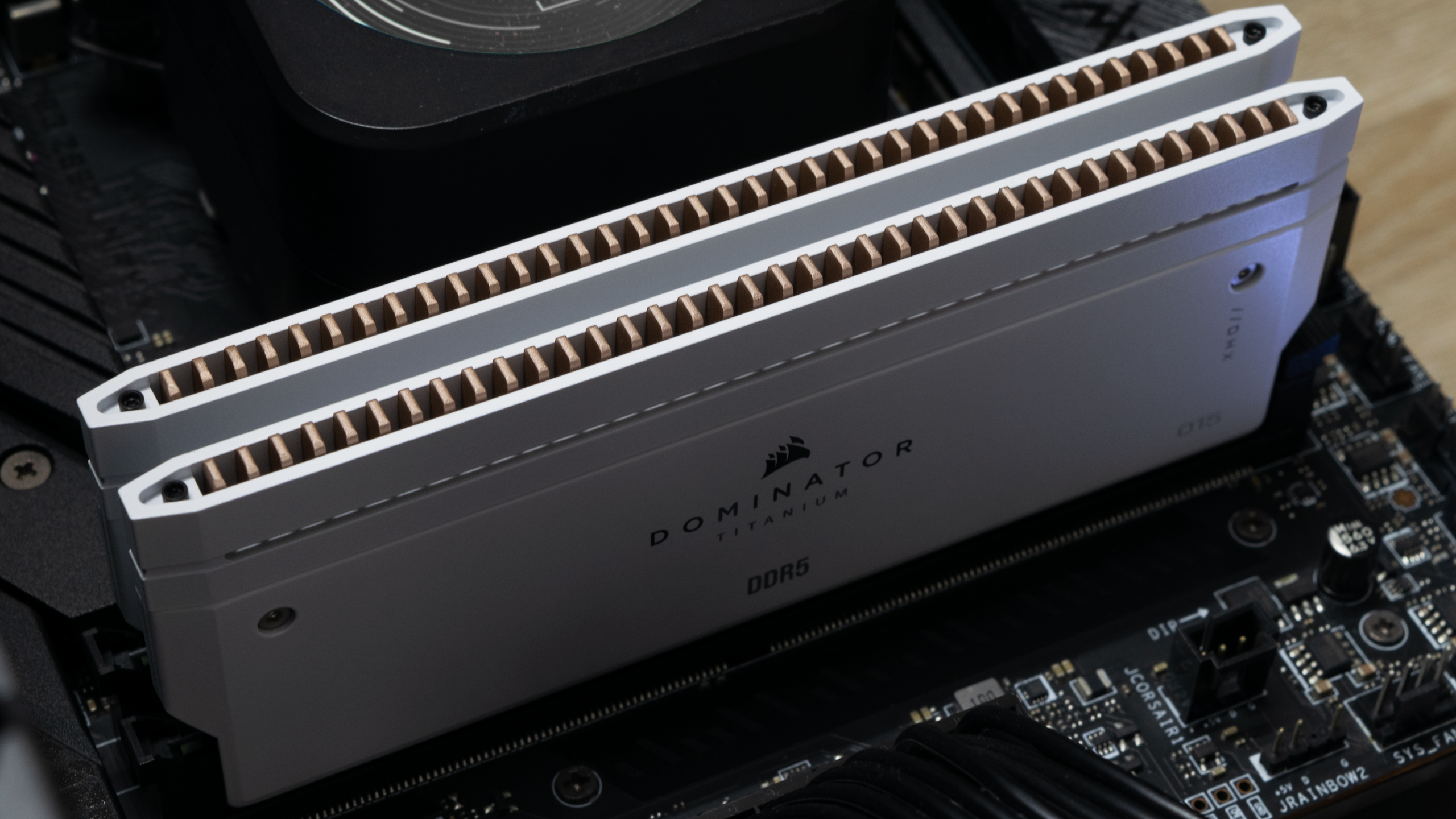
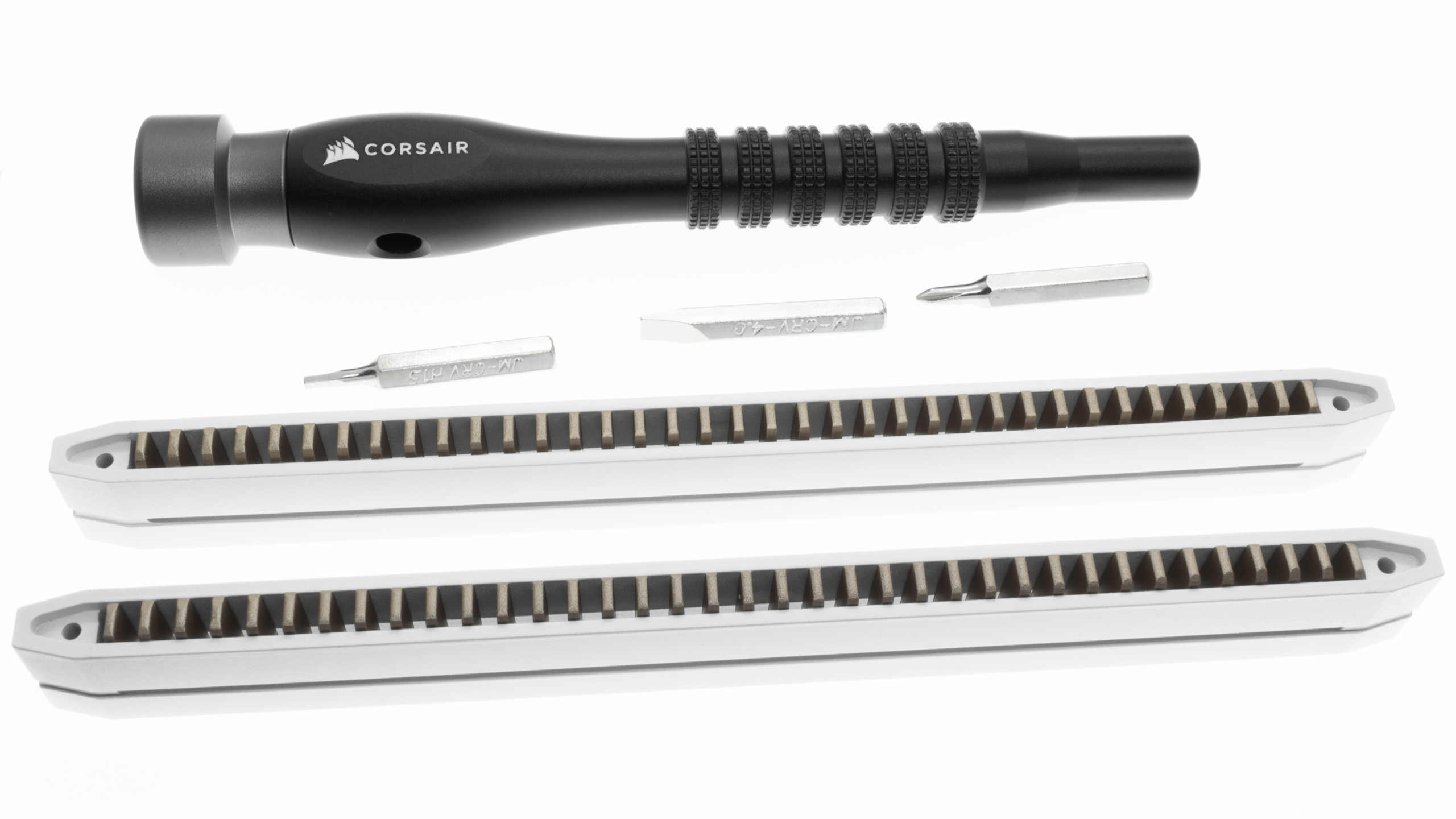
The Dominator Titanium sports a minimalistic design with an aluminum heat spreader in a single color. The Intel-branded models are available in a matte black or white color, whereas the AMD-branded variant solely comes in grey. Corsair has launched 500 units of "First Edition" memory kits, exclusive to the brand's online store, to celebrate the new Dominator Titanium series launch. Therefore, Corsair has engraved the number of the memory kit on the memory module's heat spreader.
One of the Dominator Titanium's novelties is the swappable top bar, which you can replace with separate accessory kits or 3D print your own. By default, the memory modules feature the RGB diffuser with 11 individually addressable RGB LEDs that you can control with Corsair's iCUE software. The RGB diffuser attaches to the memory module via a proprietary Corsair connector with a reversible design, so there's no way to mess it up. However, if you dislike RGB lighting, the Corsair sells the classic fin-style top bar separately for $29.99. The First Edition memory kits include the additional fin accessory kit, a screwdriver, and three bits for removal and installation.
Regardless of the top bar design, the Dominator Titanium has a height of 57mm (2.24 inches), so they're on the taller side. You should check your CPU air cooler's specification sheet to ensure enough clearance space. Corsair recommends consumers use AIO liquid coolers where feasible to avoid compatibility issues.
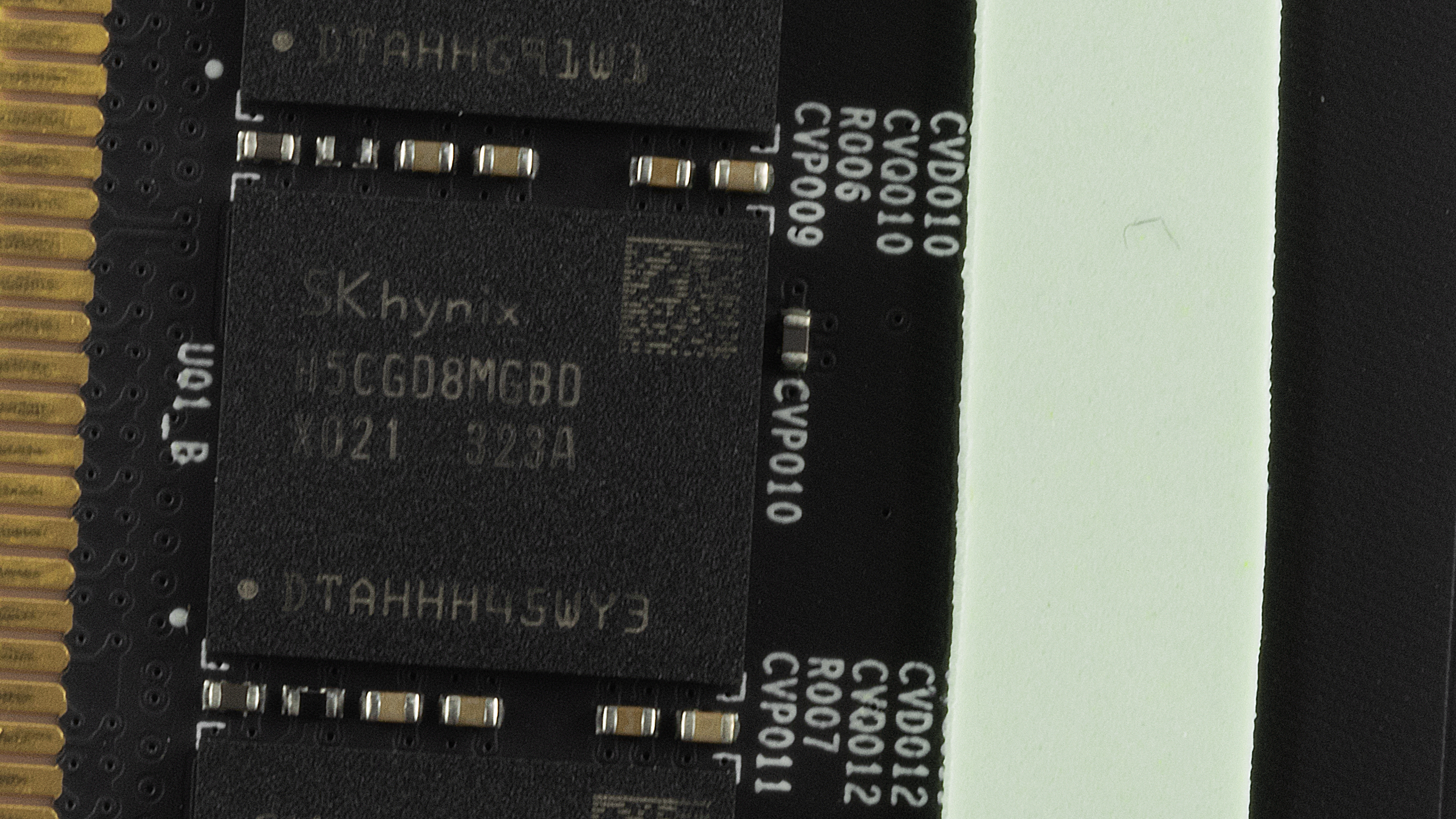
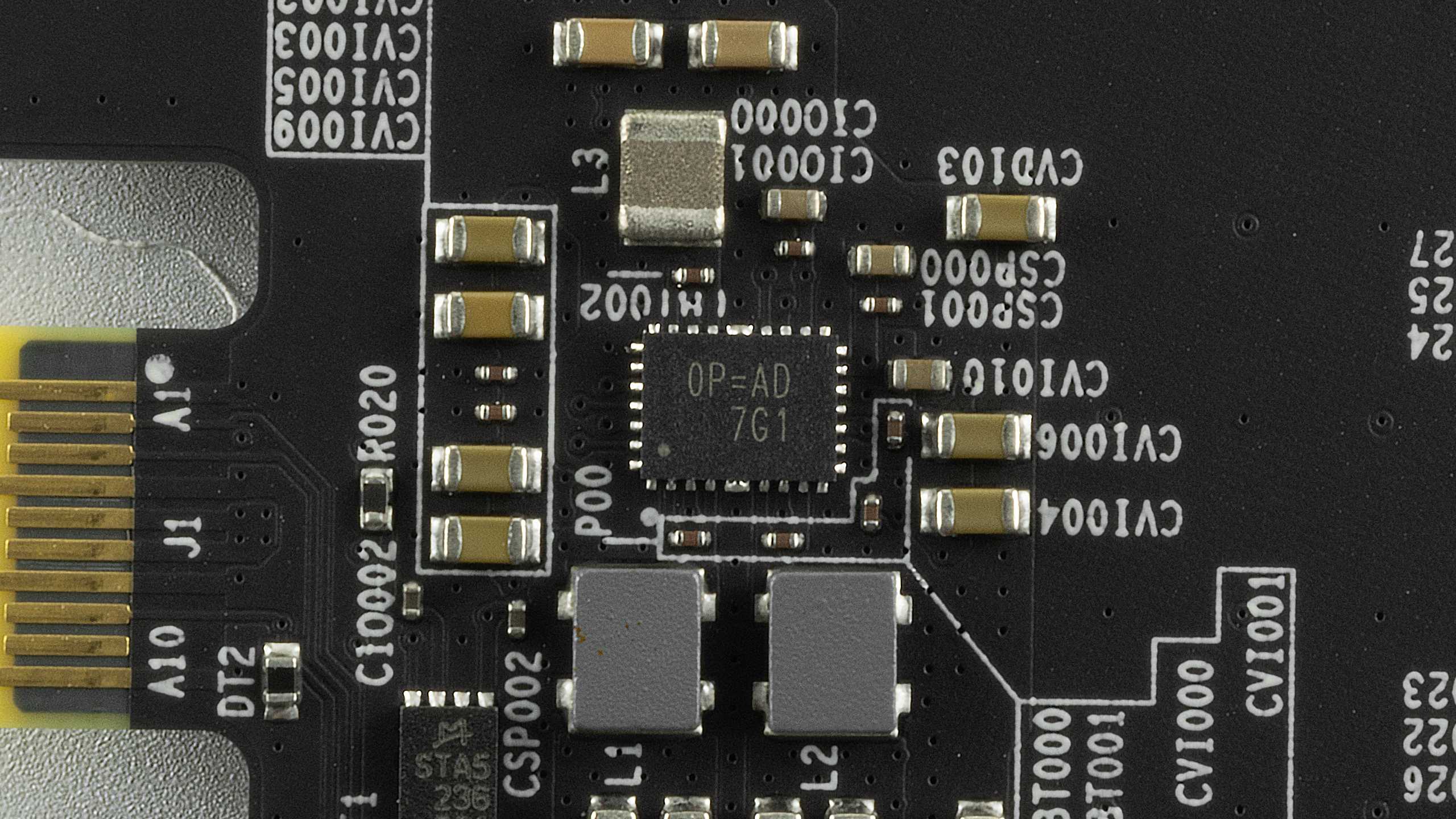
The Dominator Titanium memory modules employ a custom PCB with a special RGB connector on the top. It's a tidy implementation that breaks away from the typical design that puts the RGB LEDs on the memory module or uses a ribbon cable to connect the RGB diffuser to the PCB.
This specific Dominator Titanium memory kit sports a single-rank design and a capacity of 24GB. The eight H5CGD8MHBDX021 integrated circuits (ICs) belong to SK hynix. These are still M-die ICs but in their 3GB form as opposed to the 2GB variants used by vendors inside 16GB memory modules. As for the power management IC (PMIC), Corsair chose the 0P=AD 7G1 unit from Richtek.
The memory defaults to DDR5-4800 with 40-40-40-77 timings for guaranteed compatibility. It contains two XMP 3.0 profiles. The standard profile corresponds to DDR5-7200 with 36-46-46-116 timings at 1.4V. The overclocked profile is for DDR5-7400 38-48-48-120 at 1.4V. It's great to see manufacturers finally taking advantage of all the XMP 3.0 storage space. Corsair provides a small factory overclocked profile for less experienced users in this case. See our PC Memory 101 feature and How to Shop for RAM story for more timings and frequency considerations.
Get Tom's Hardware's best news and in-depth reviews, straight to your inbox.
Comparison Hardware
| Memory Kit | Part Number | Capacity | Data Rate | Primary Timings | Voltage | Warranty |
|---|---|---|---|---|---|---|
| G.Skill Trident Z5 RGB | F5-7200J3646F24GX2-TZ5RK | 2 x 24GB | DDR5-7200 (XMP) | 36-46-46-115 (2T) | 1.35 | Lifetime |
| Corsair Dominator Titanium First Edition | CMP48GX5M2X7200C36FEW | 2 x 24GB | DDR5-7200 (XMP) | 36-46-46-116 (2T) | 1.40 | Lifetime |
| Corsair Dominator Titanium First Edition | CMP64GX5M2X6600C32FEW | 2 x 32GB | DDR5-6600 (XMP) | 32-39-39-76 (2T) | 1.40 | Lifetime |
| G.Skill Trident Z5 RGB | F5-6400J3239G32GX2-TZ5RW | 2 x 32GB | DDR5-6400 (XMP) | 32-39-39-102 (2T) | 1.40 | Lifetime |
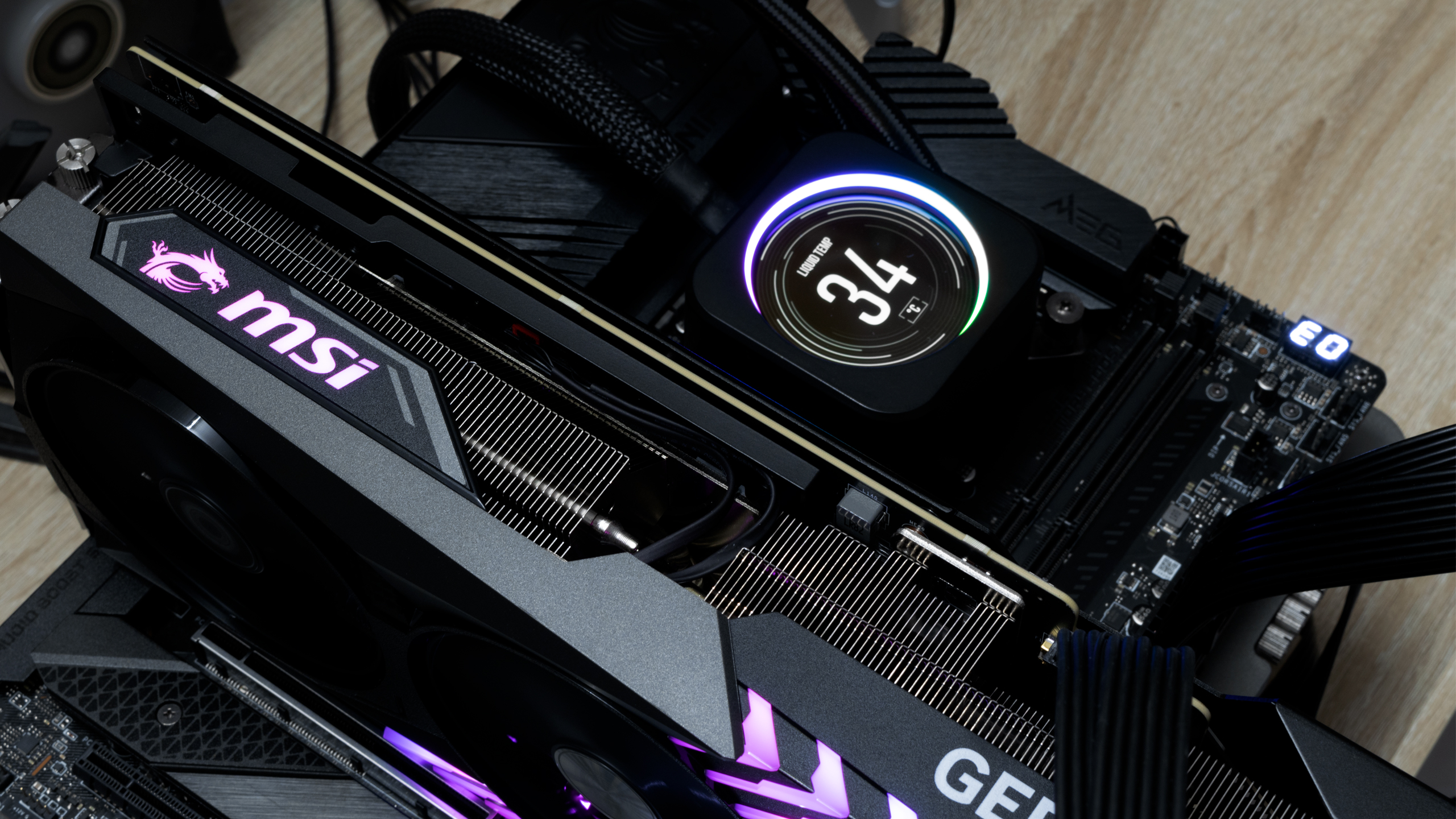
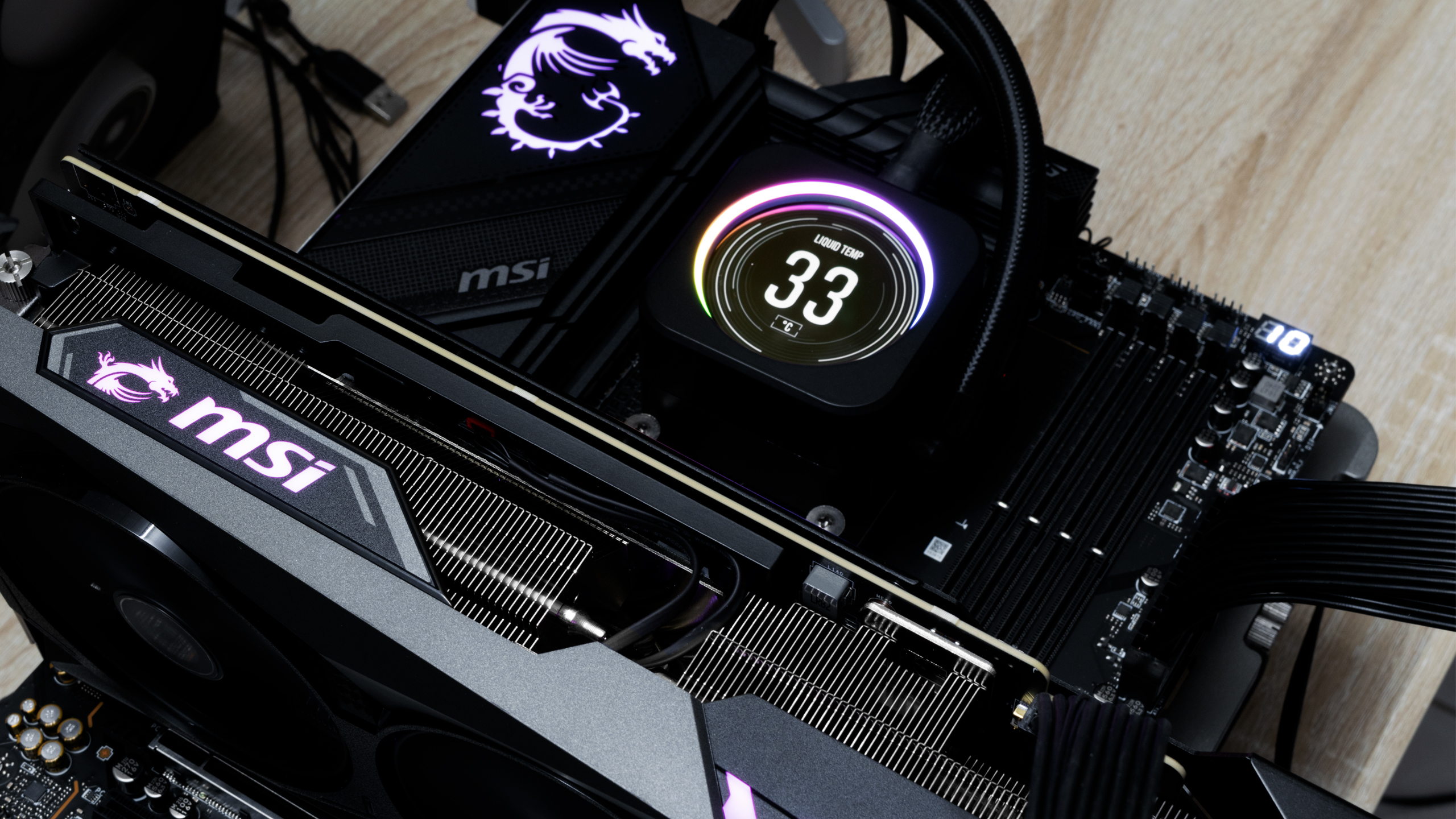
The Intel system runs the Core i9-13900K on the MSI MEG Z690 Unify-X with the 7D28vAA firmware. In contrast, the AMD system pairs the Ryzen 7 7700X with the MSI MPG X670E Carbon WiFi changed to the 7D70v18 firmware. The Corsair CUE H100i Elite LCD liquid cooler keeps our Raptor Lake and Zen 4 processor operating temperatures under check.
The MSI GeForce RTX 4080 16GB Gaming X Trio tackles the more graphics-intensive workloads, ensuring that there isn't a graphics bottleneck in our gaming RAM benchmarks. The Windows 11 installation, benchmarking software, and games reside on Crucial's MX500 SSDs. Meanwhile, the Corsair RM1000x Shift ATX 3.0 power supply provides our systems with clean and abundant power, directly feeding the GeForce RTX 4080 with a native 16-pin (12VHPWR) power cable. Lastly, the Streacom BC1 open-air test bench is vital to organizing our hardware.
| Component | Intel System | AMD System |
|---|---|---|
| Processor | Intel Core i9-13900K | AMD Ryzen 7 7700X |
| Motherboard | MSI MEG Z690 Unify-X | MSI MPG X670E Carbon WiFi |
| Graphics Card | MSI GeForce RTX 4080 16GB Gaming X Trio | MSI GeForce RTX 4080 16GB Gaming X Trio |
| Storage | Crucial MX500 500GB, 2TB | Crucial MX500 500GB, 2TB |
| Cooling | Corsair iCUE H100i Elite LCD | Corsair iCUE H100i Elite LCD |
| Power Supply | Corsair RM1000x Shift | Corsair RM1000x Shift |
| Case | Streacom BC1 | Streacom BC1 |
Intel Performance
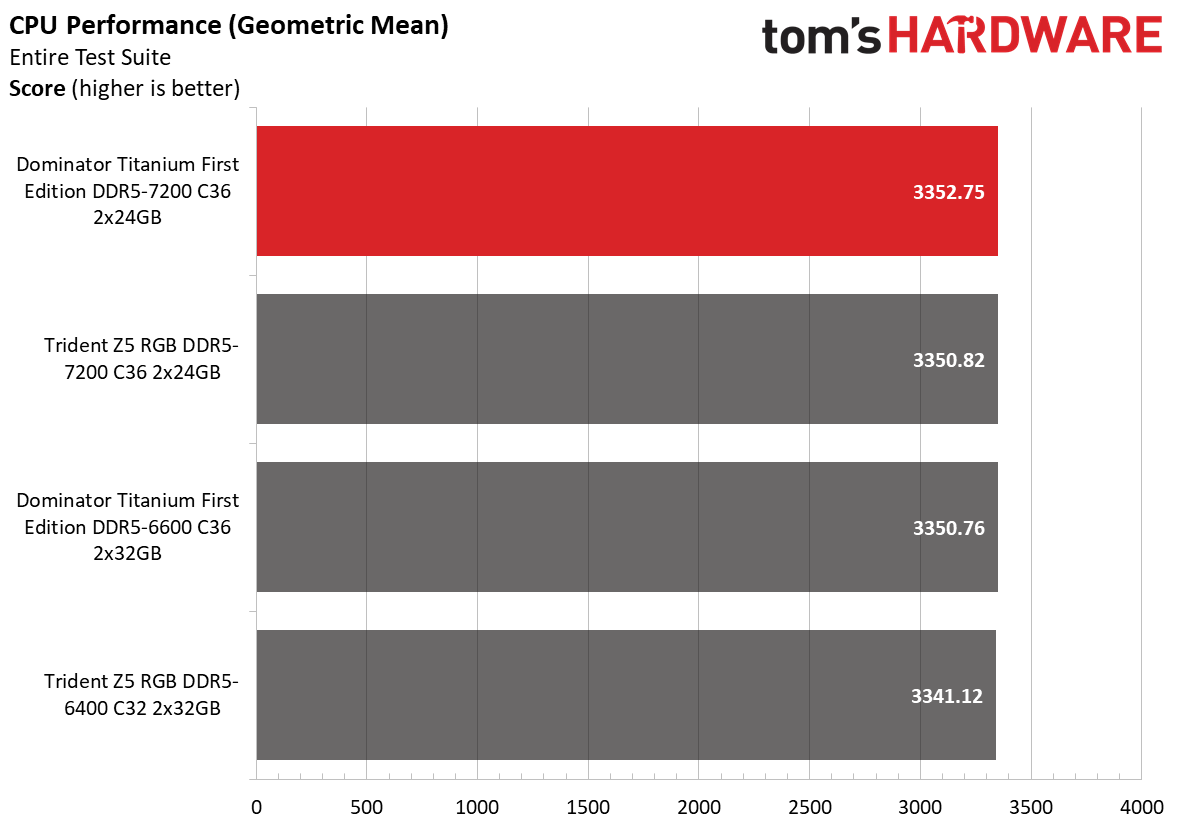
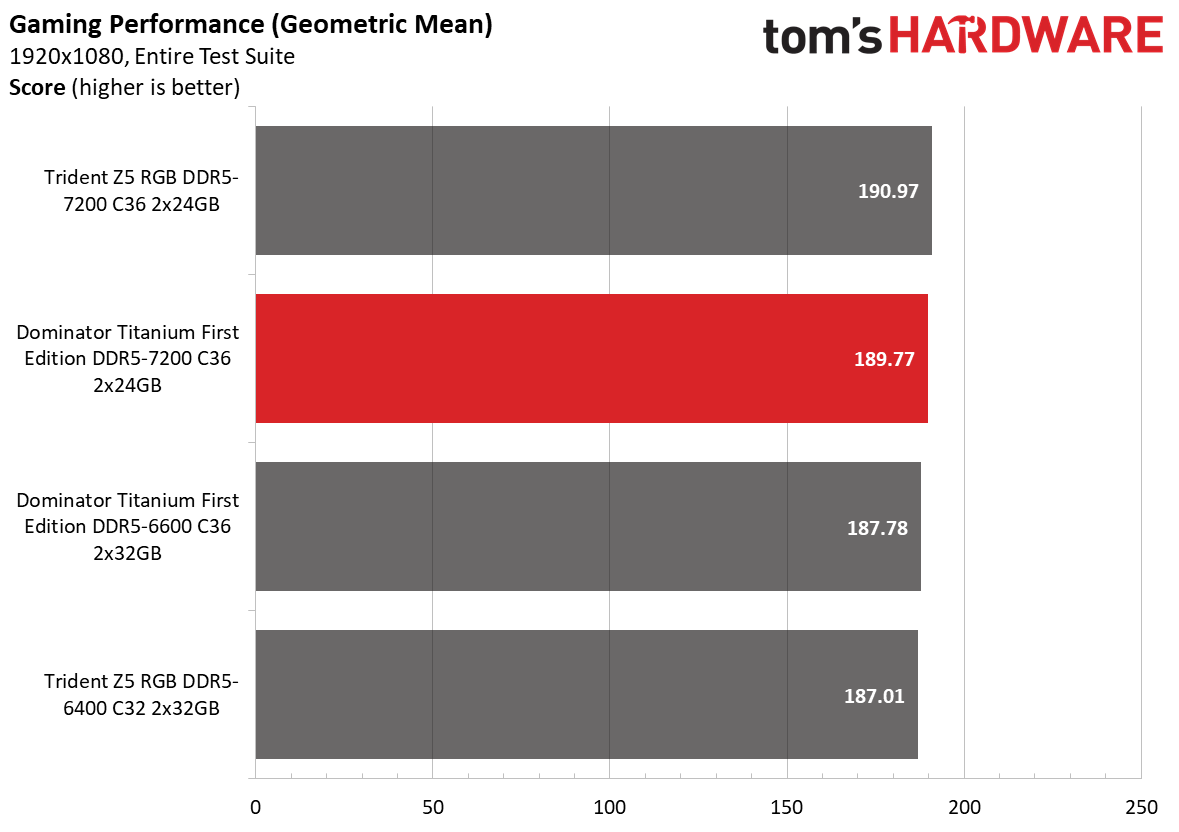
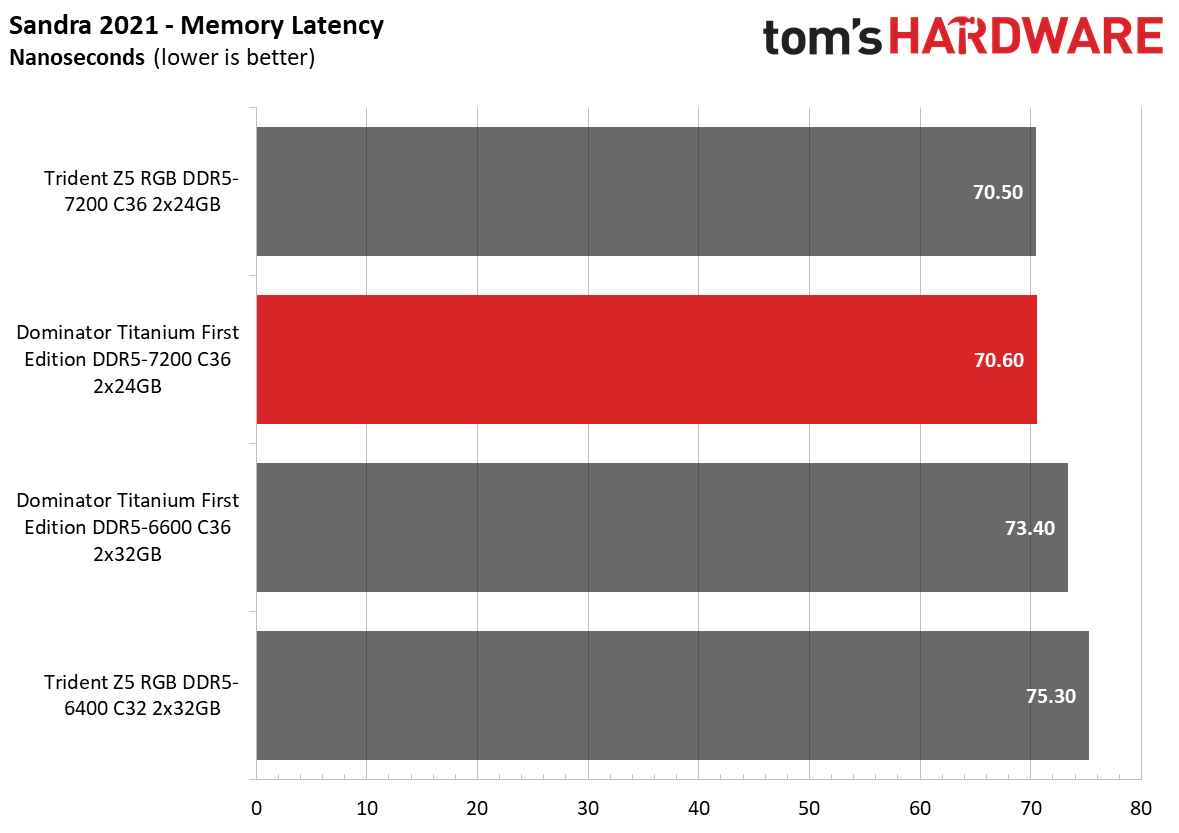


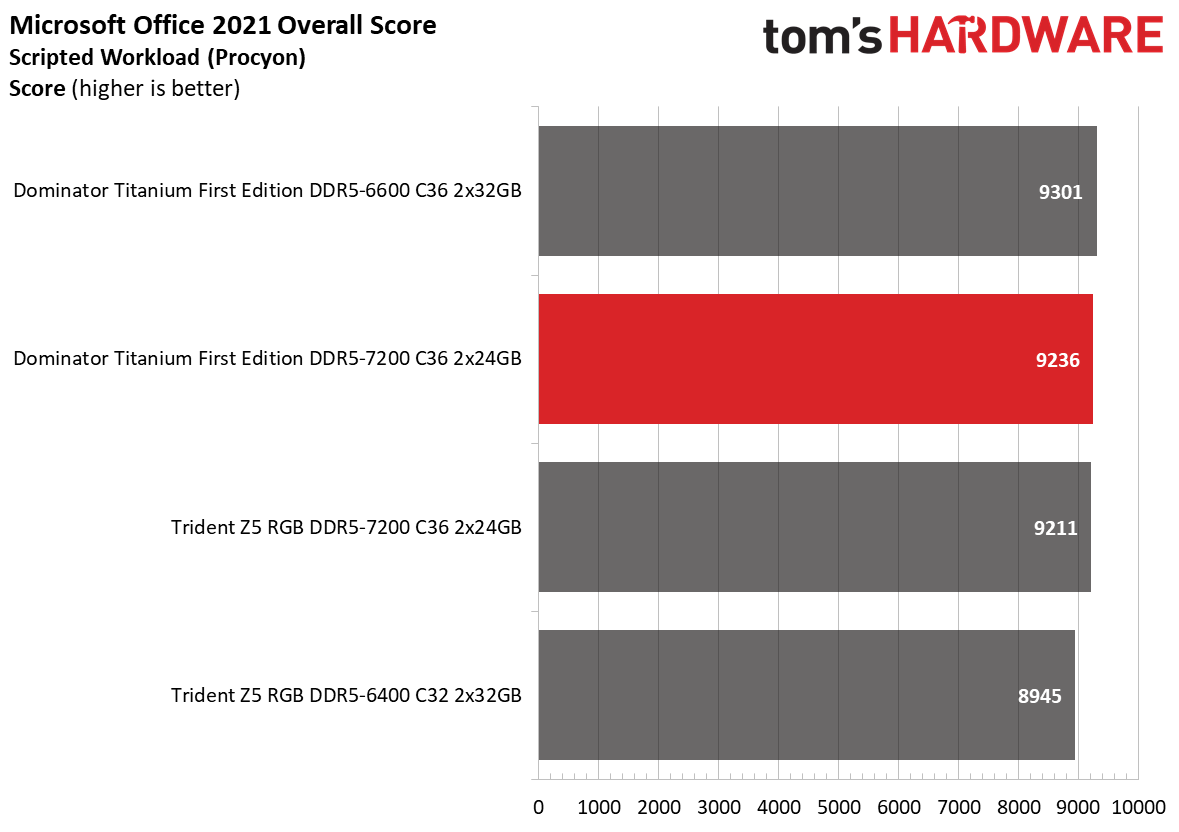
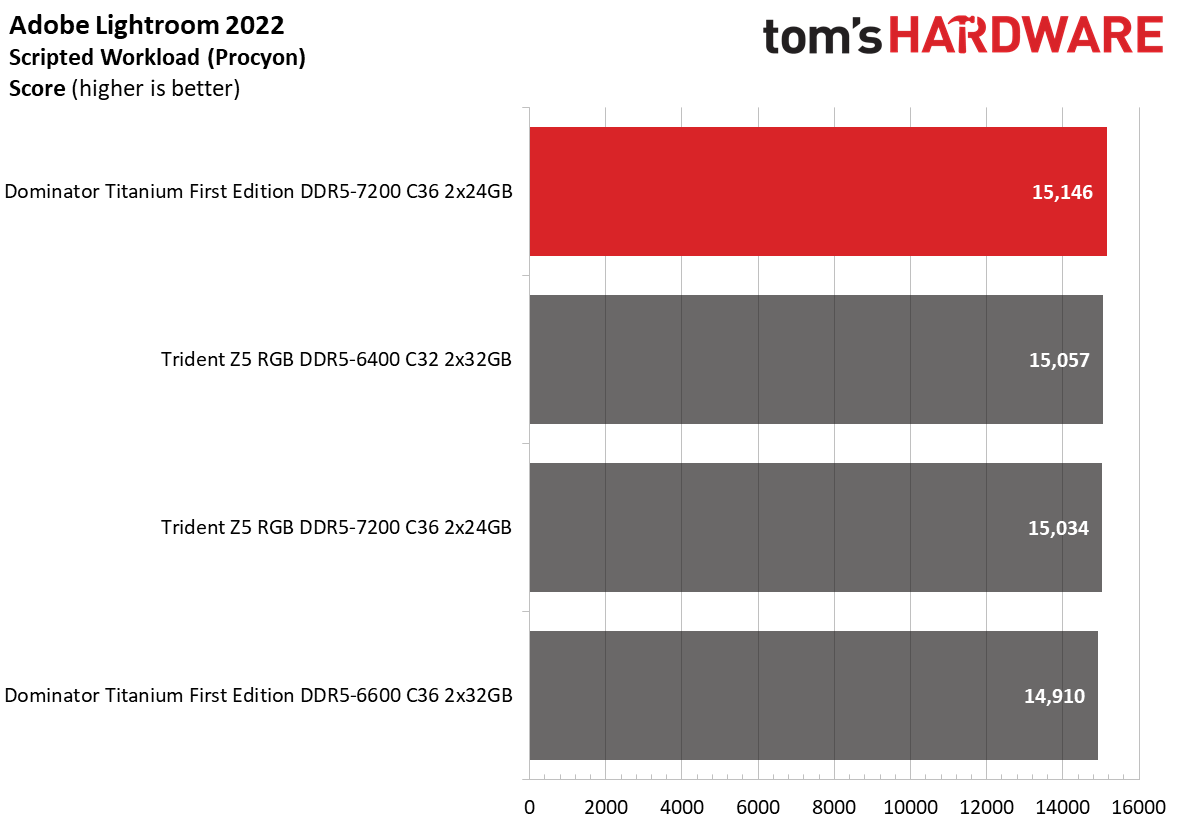
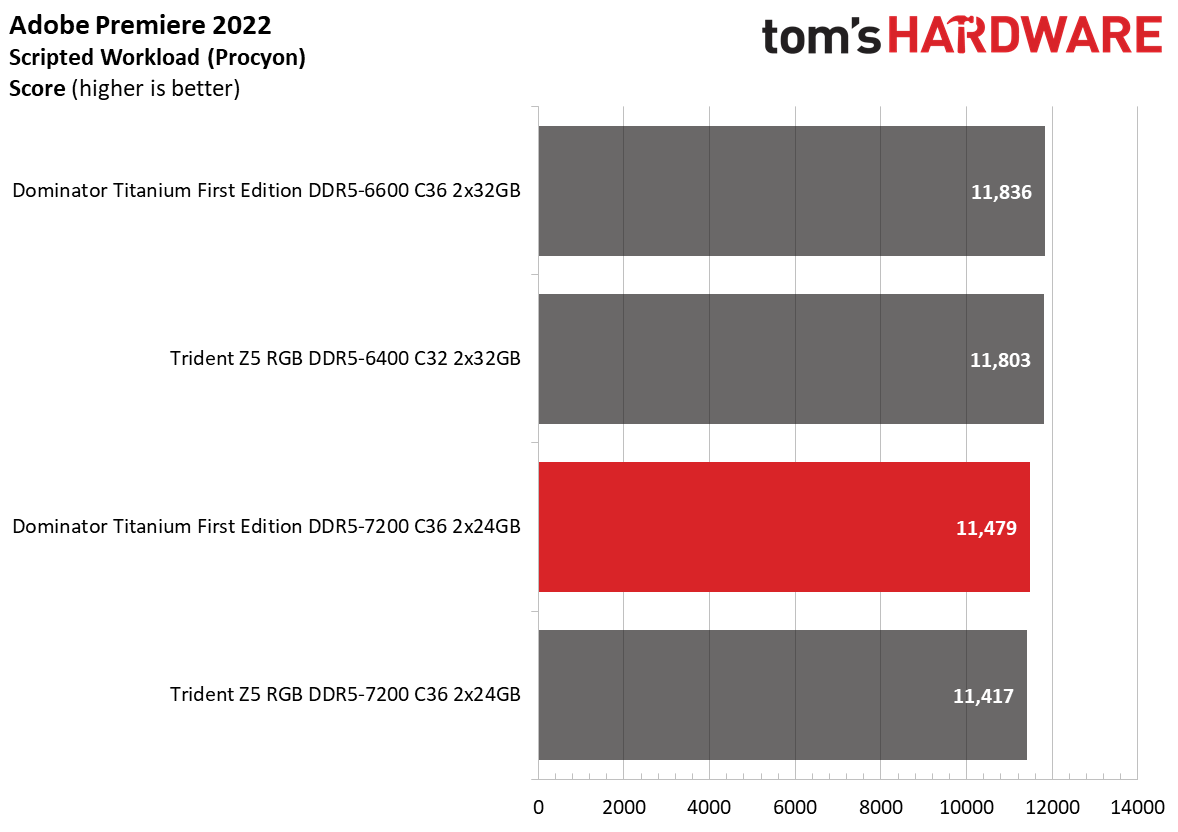
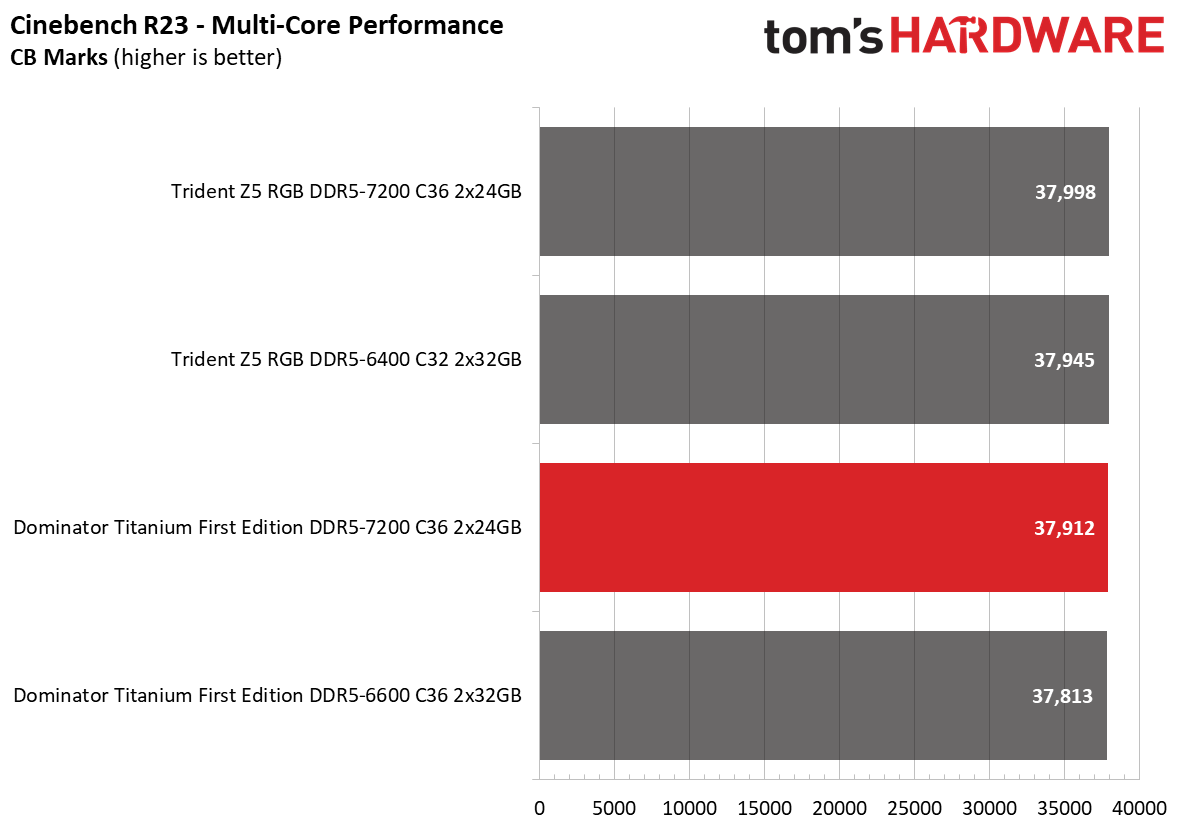
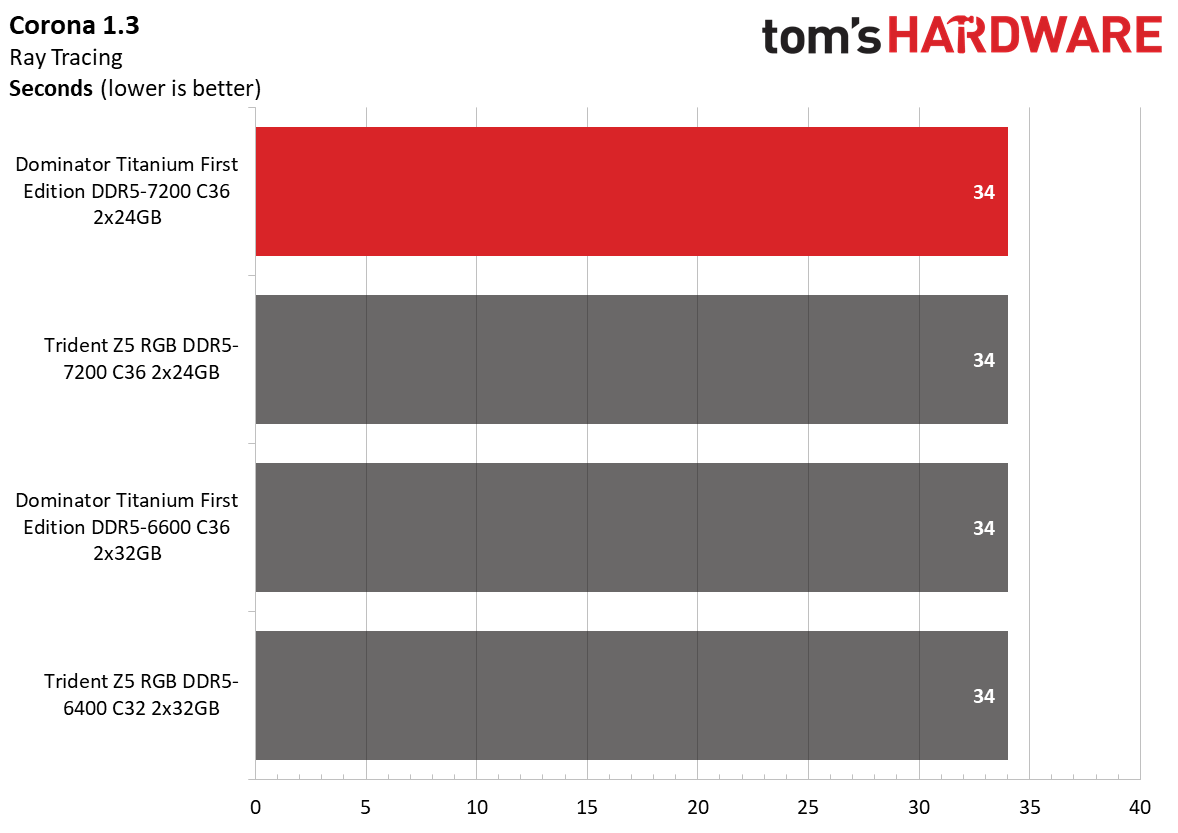
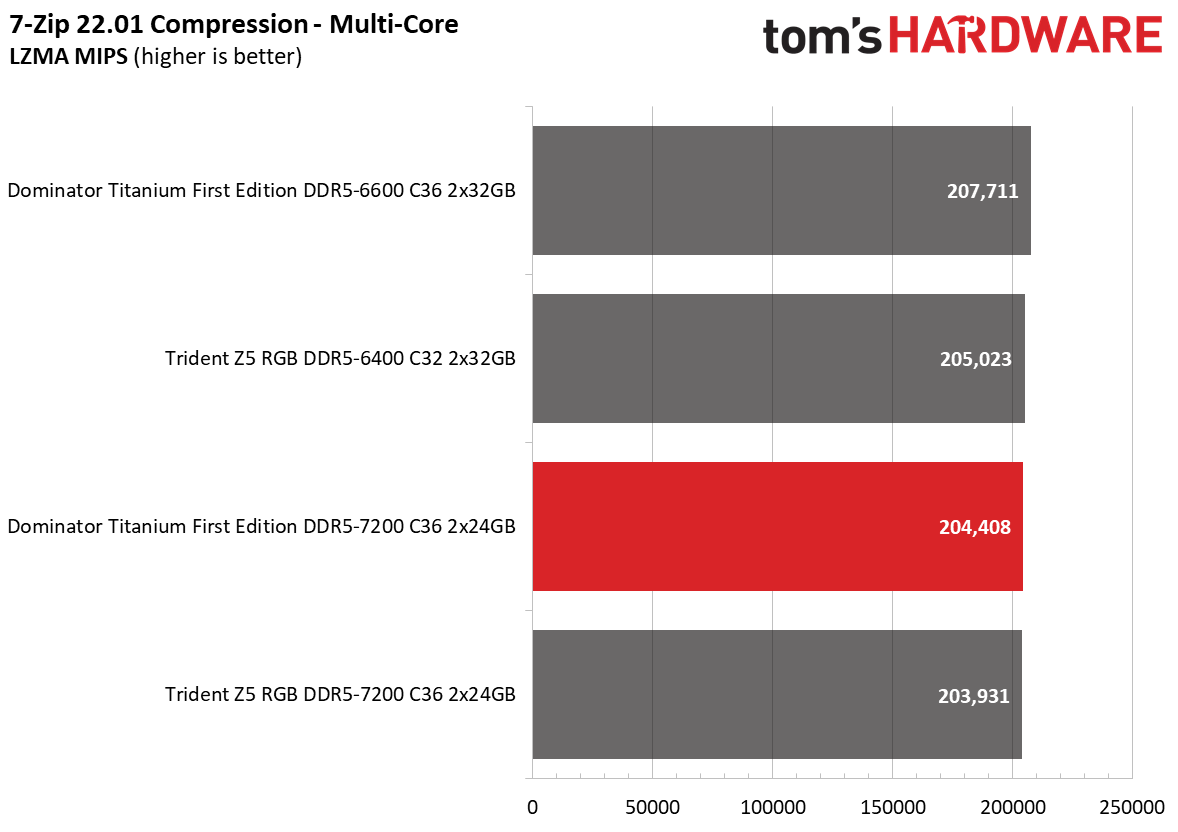
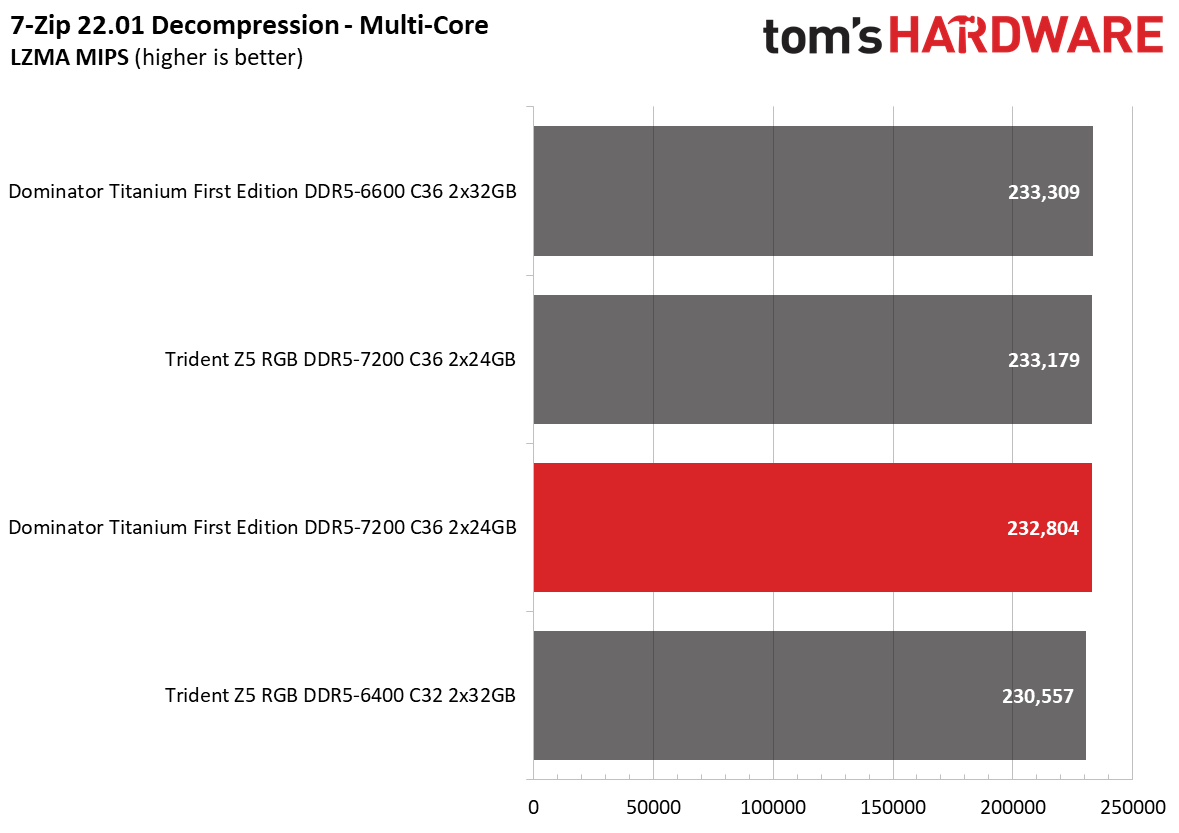
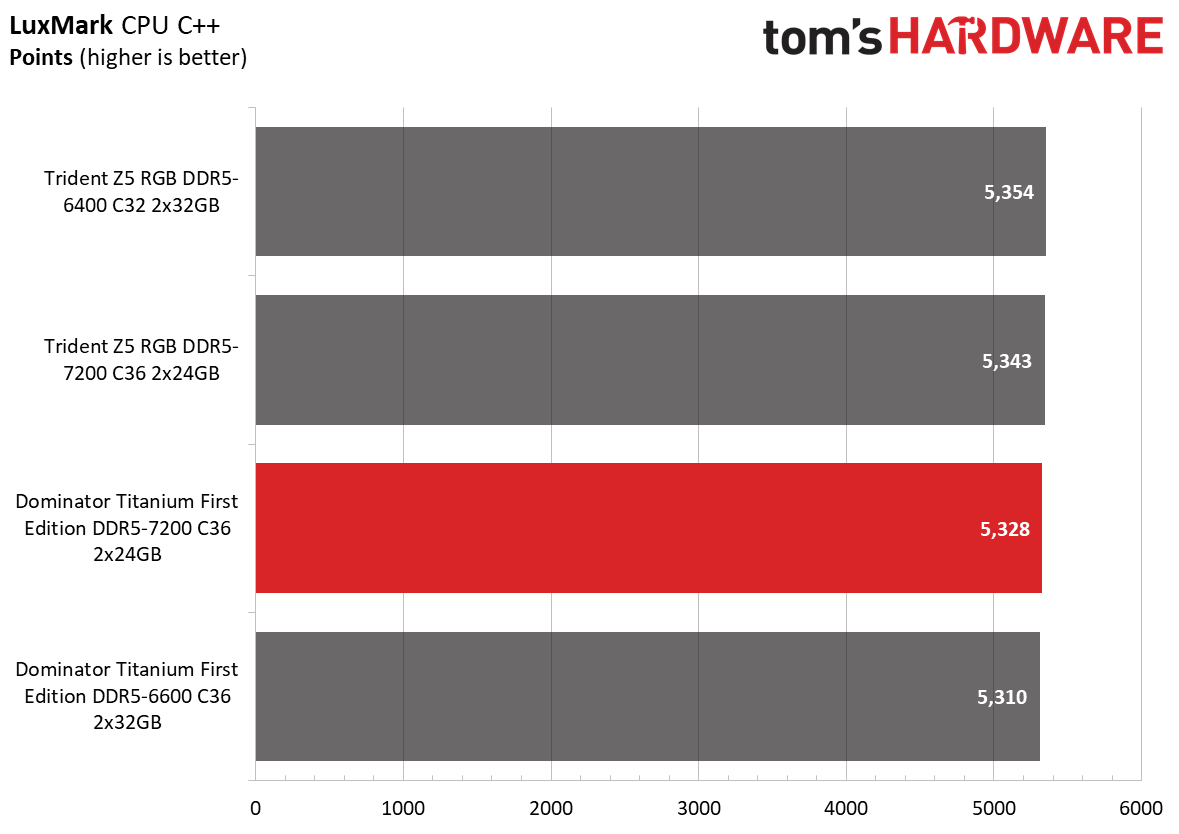
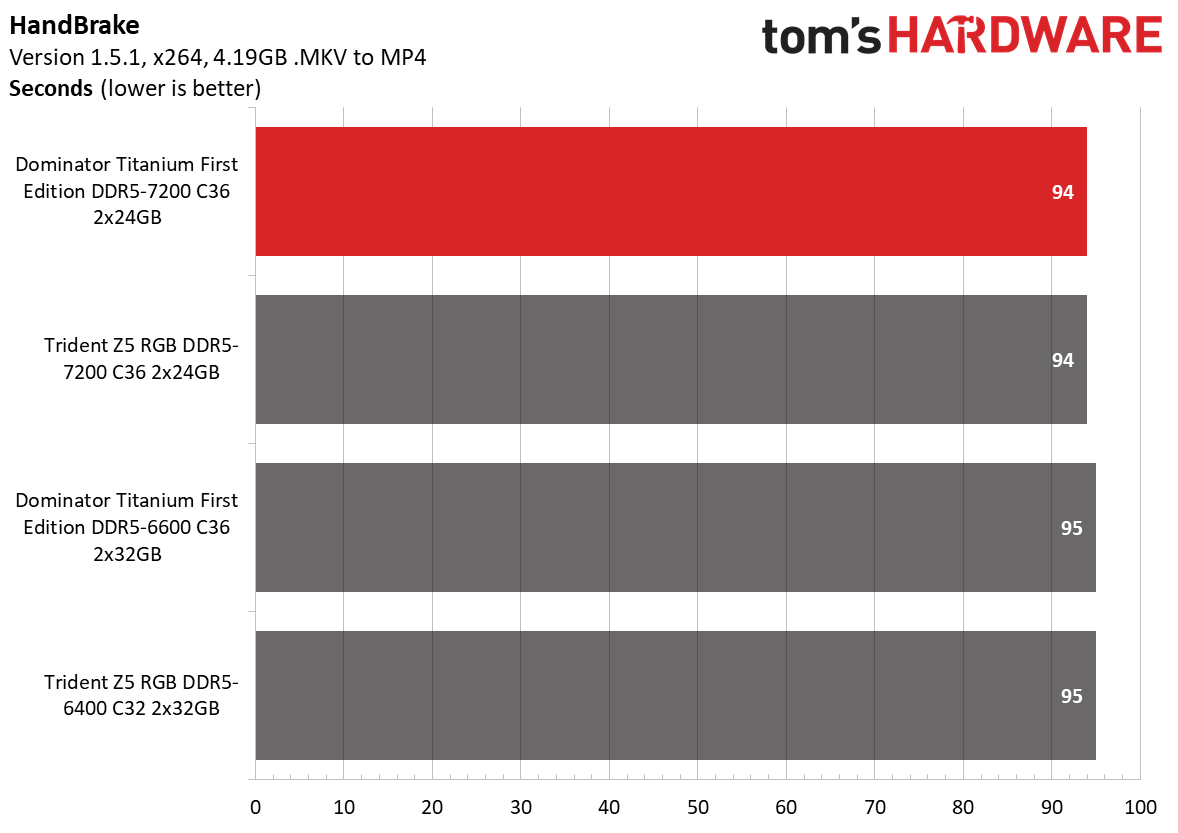

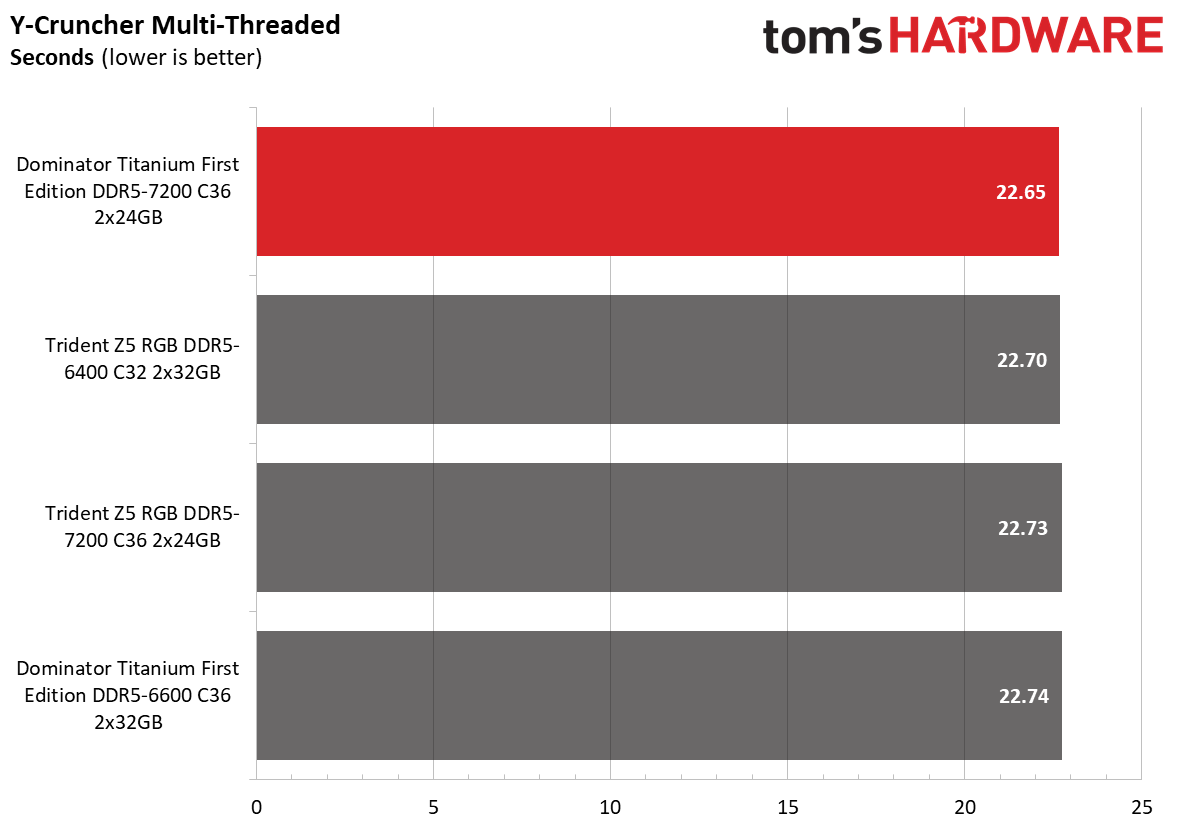
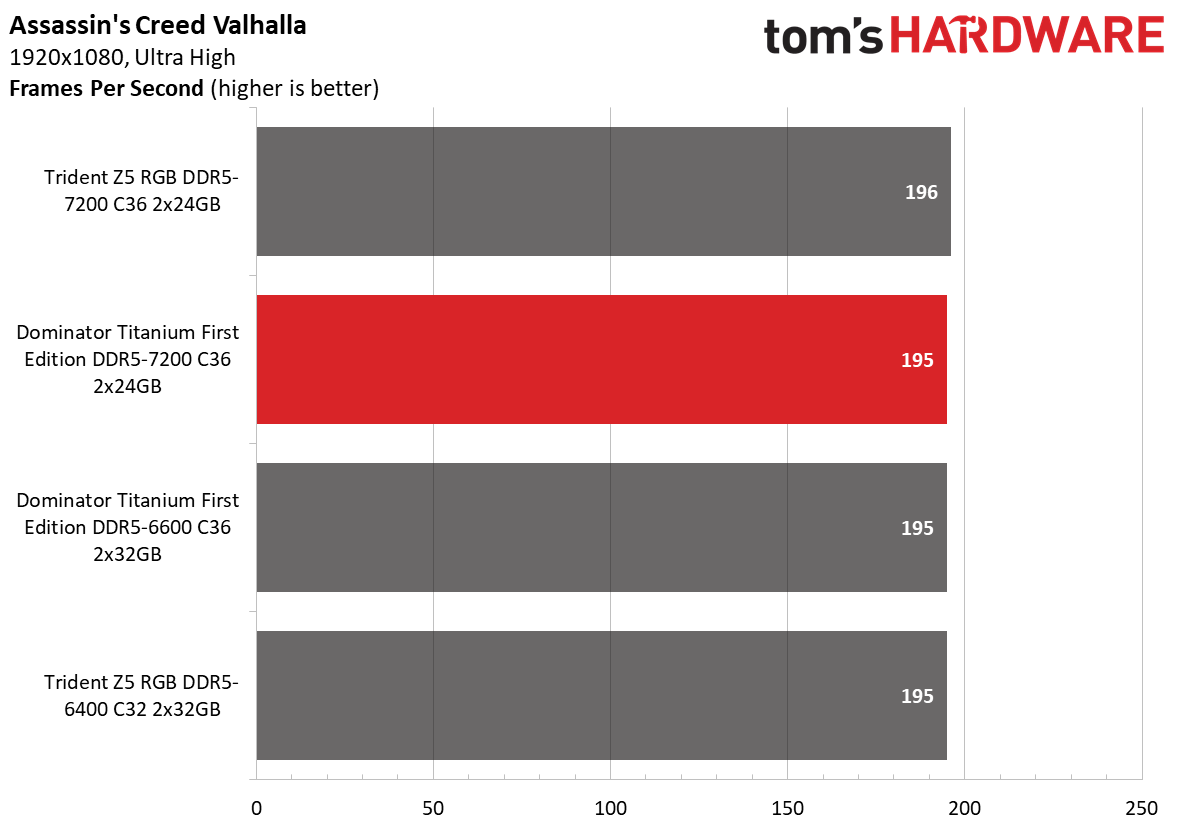
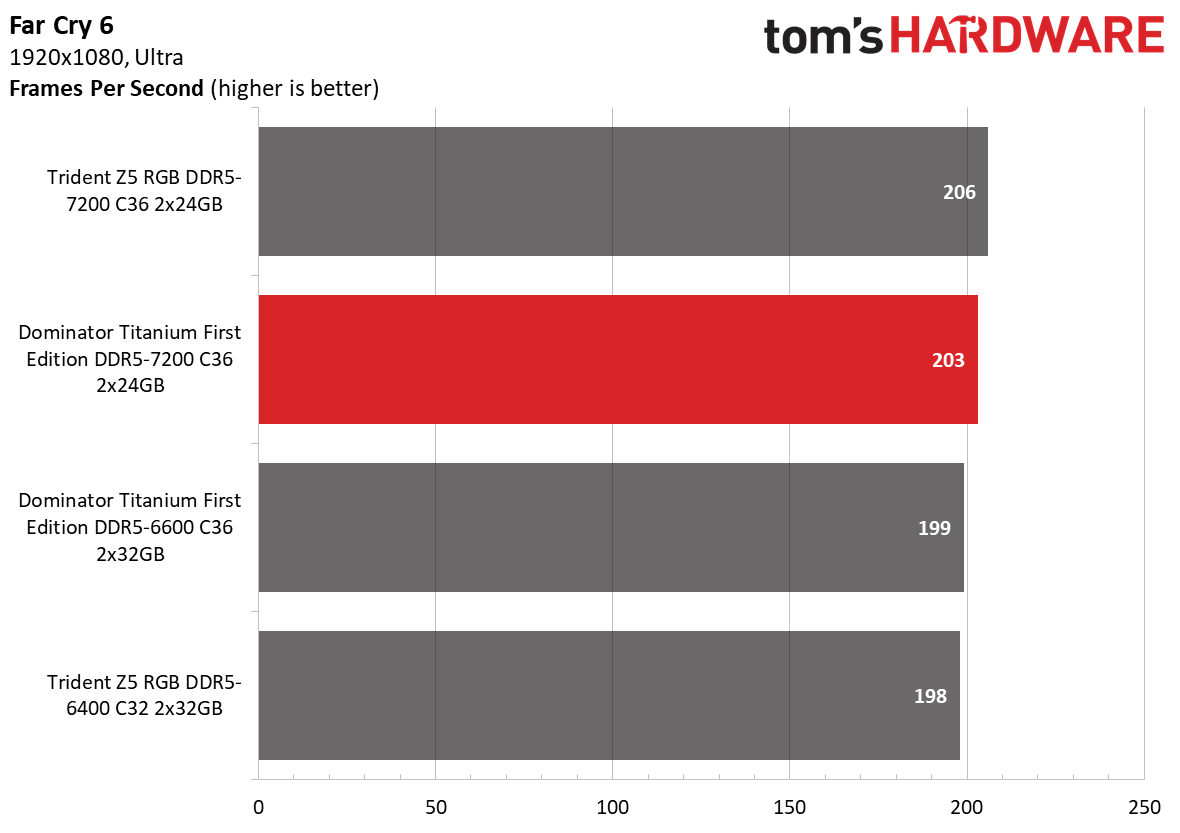
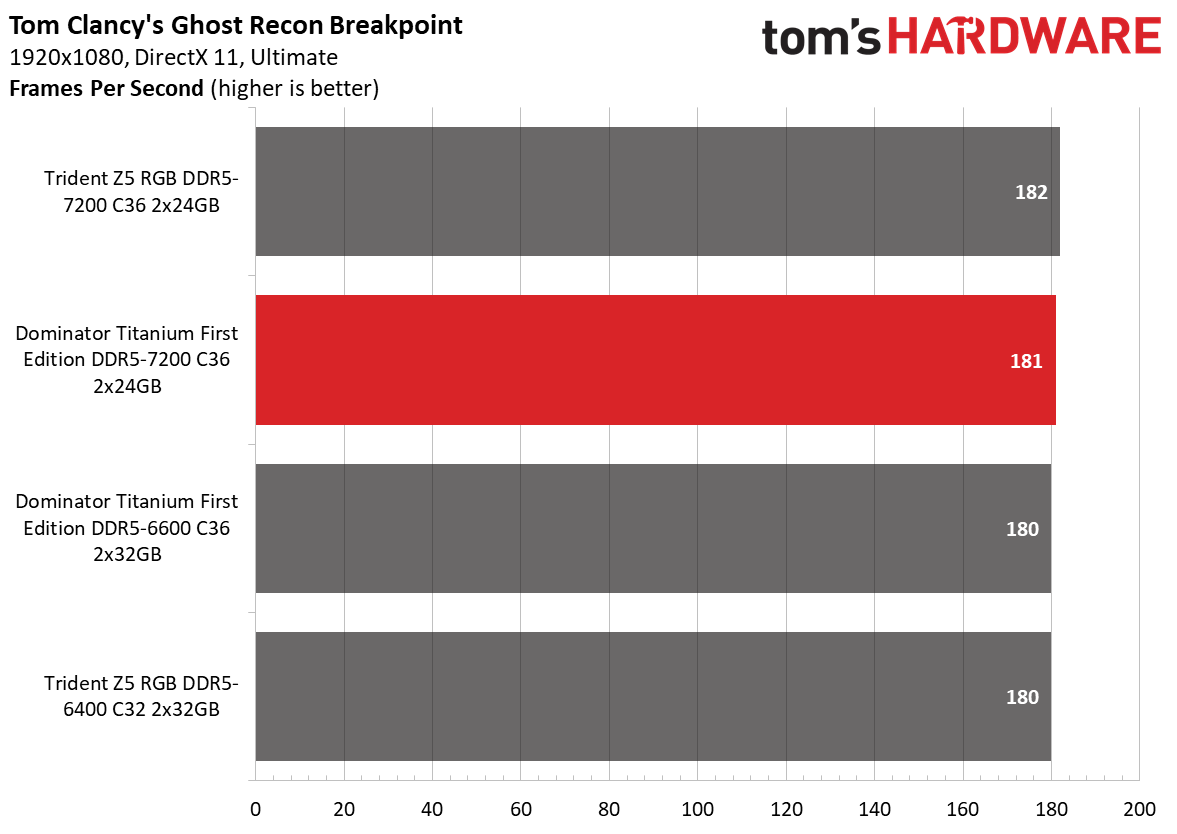

The Dominator Titanium took first place in the cumulative application performance chart. The memory kit outperformed the 4GB (2x32GB) competitors despite some workloads, such as Adobe Premiere, that favor higher-capacity memory kits. It wasn't a huge lead, but enough to put the Dominator Titanium at the top.
AMD Performance
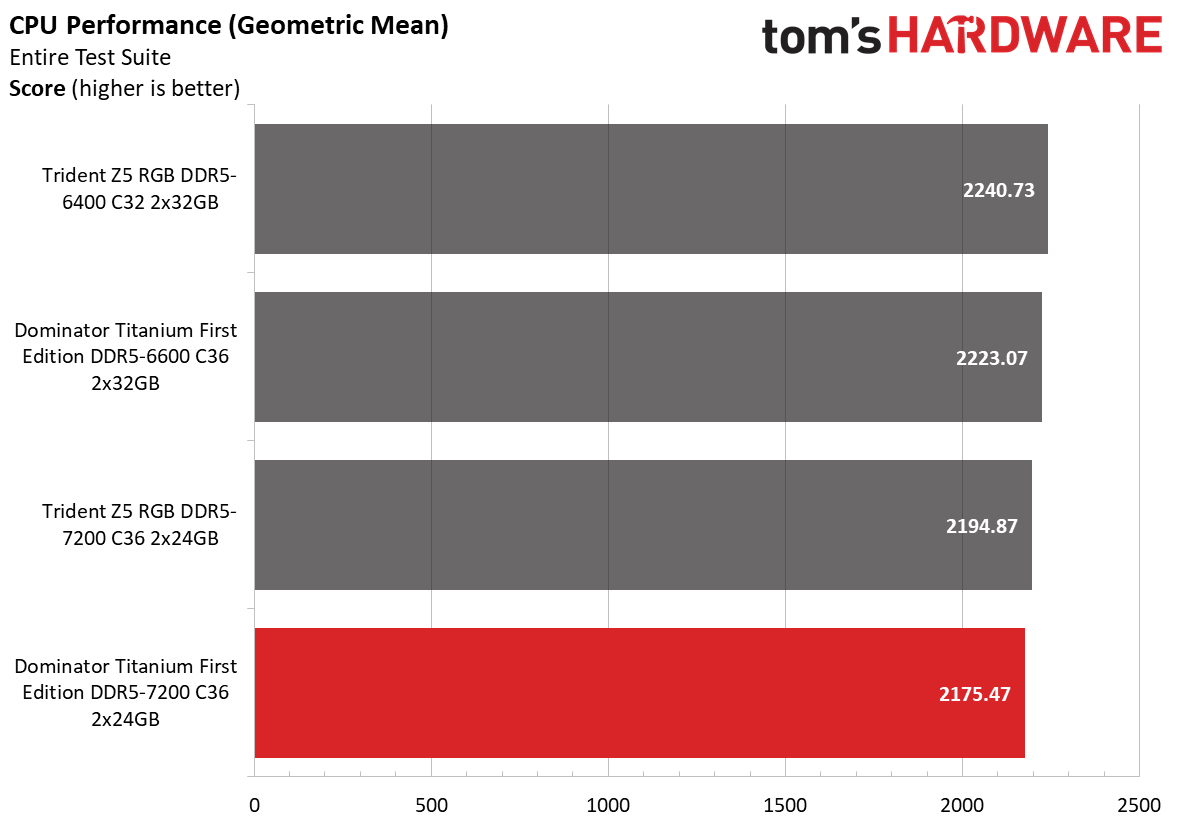

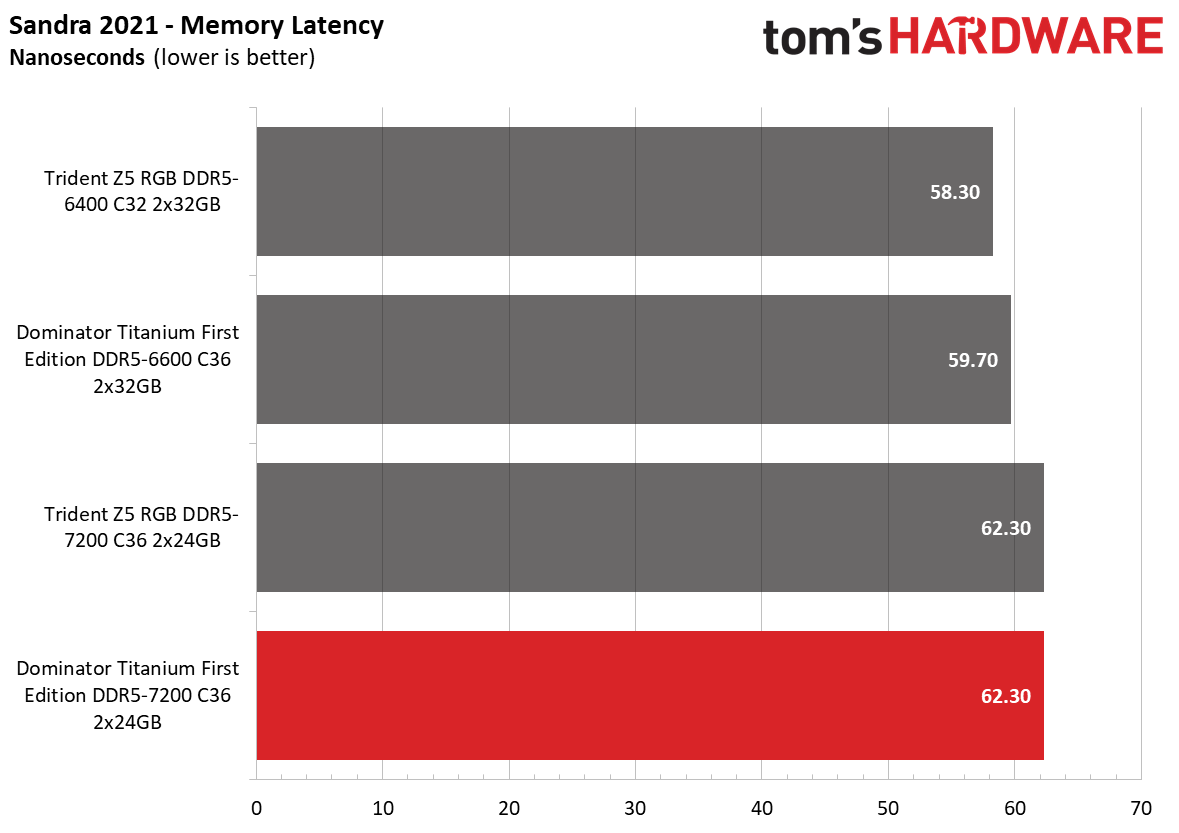
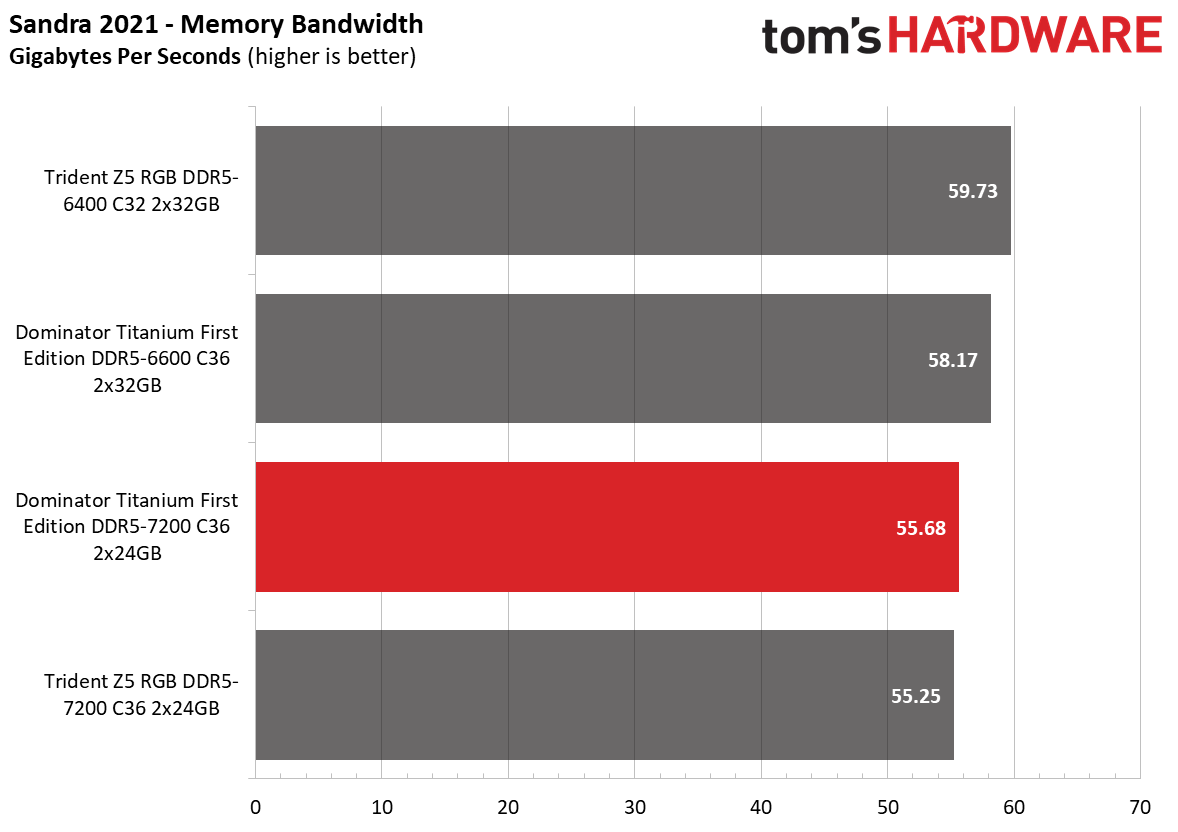
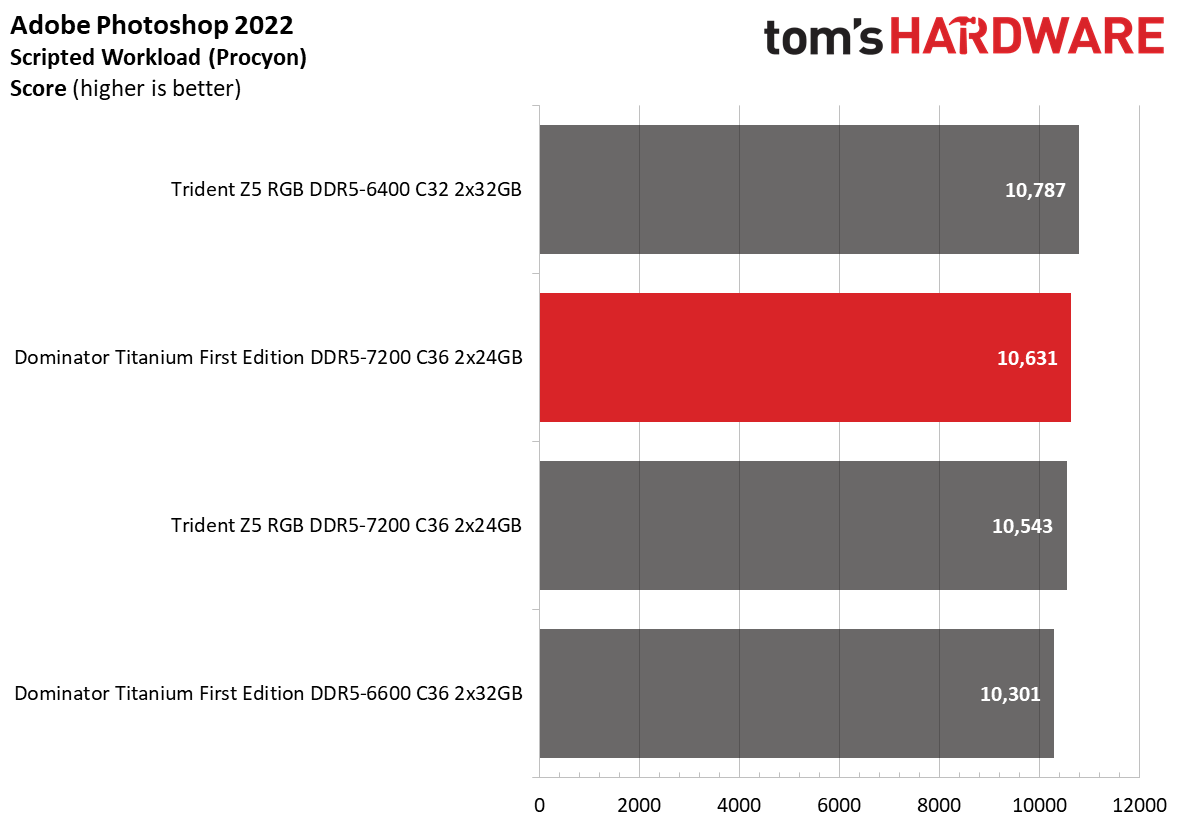
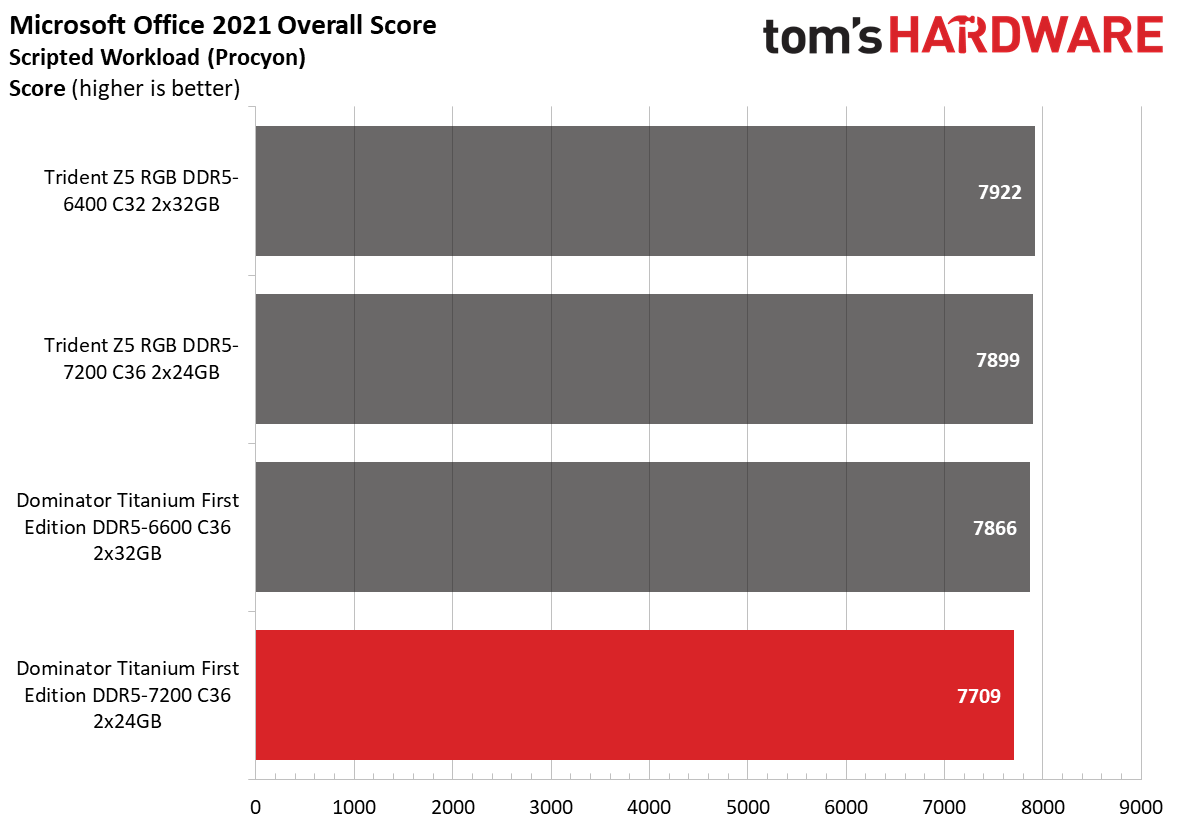

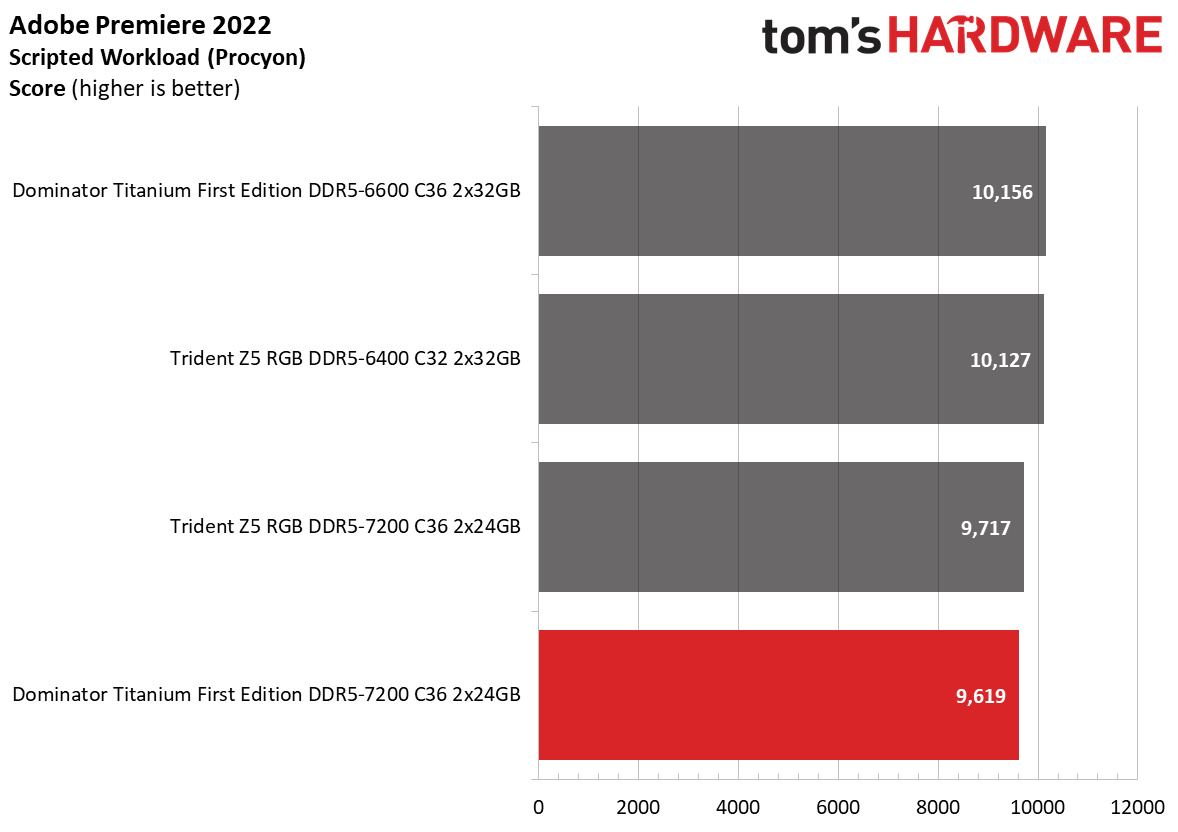
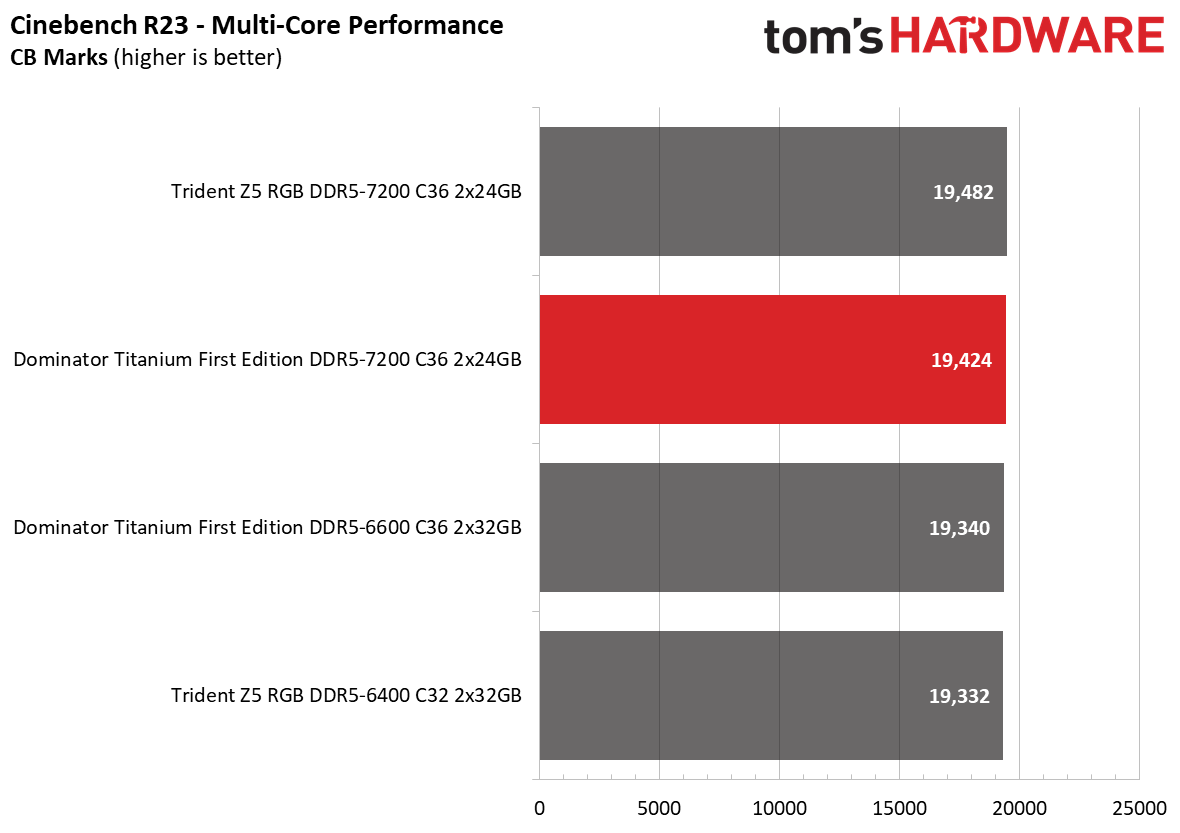
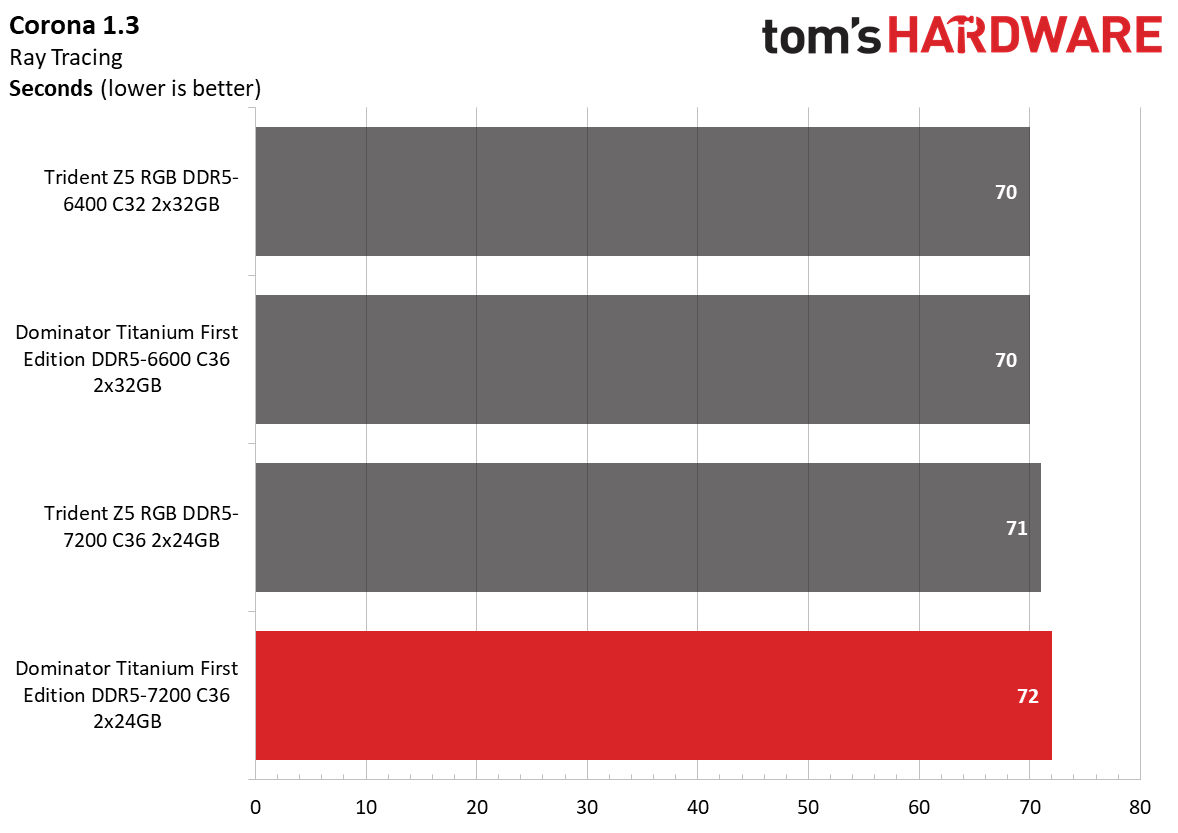
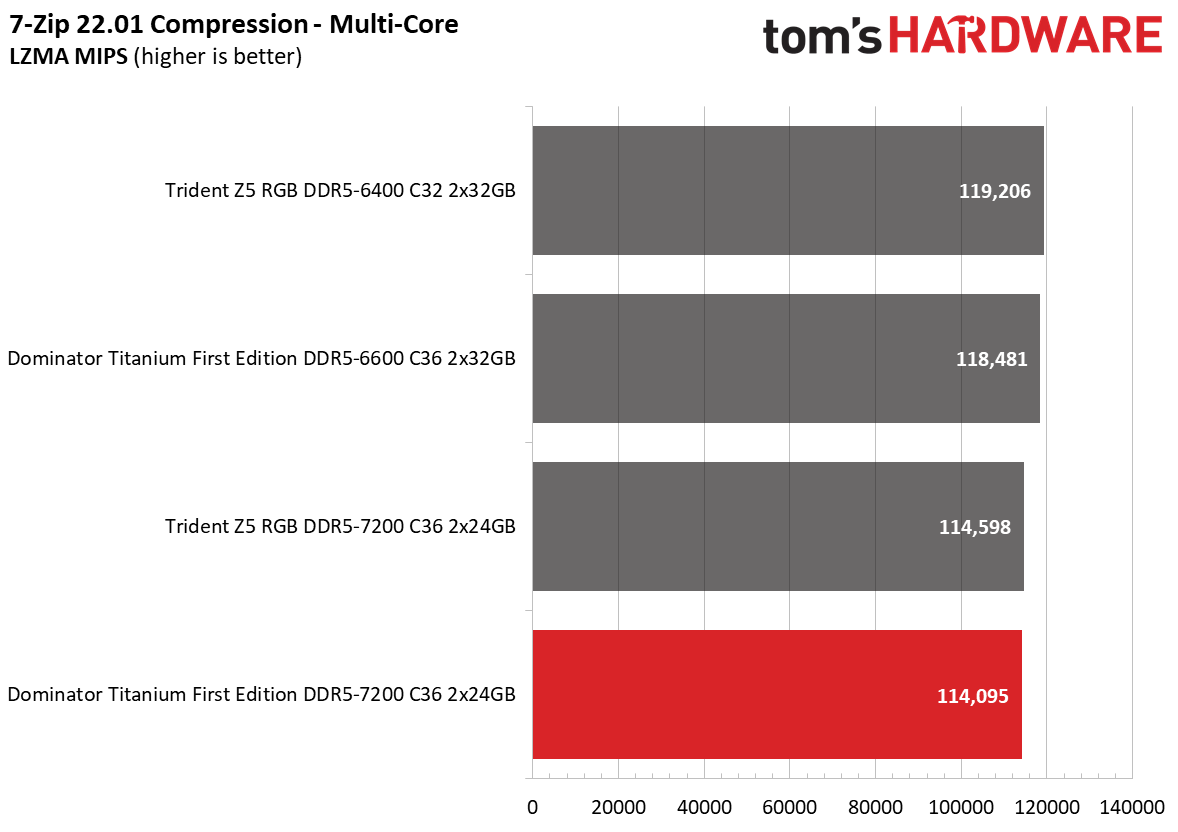
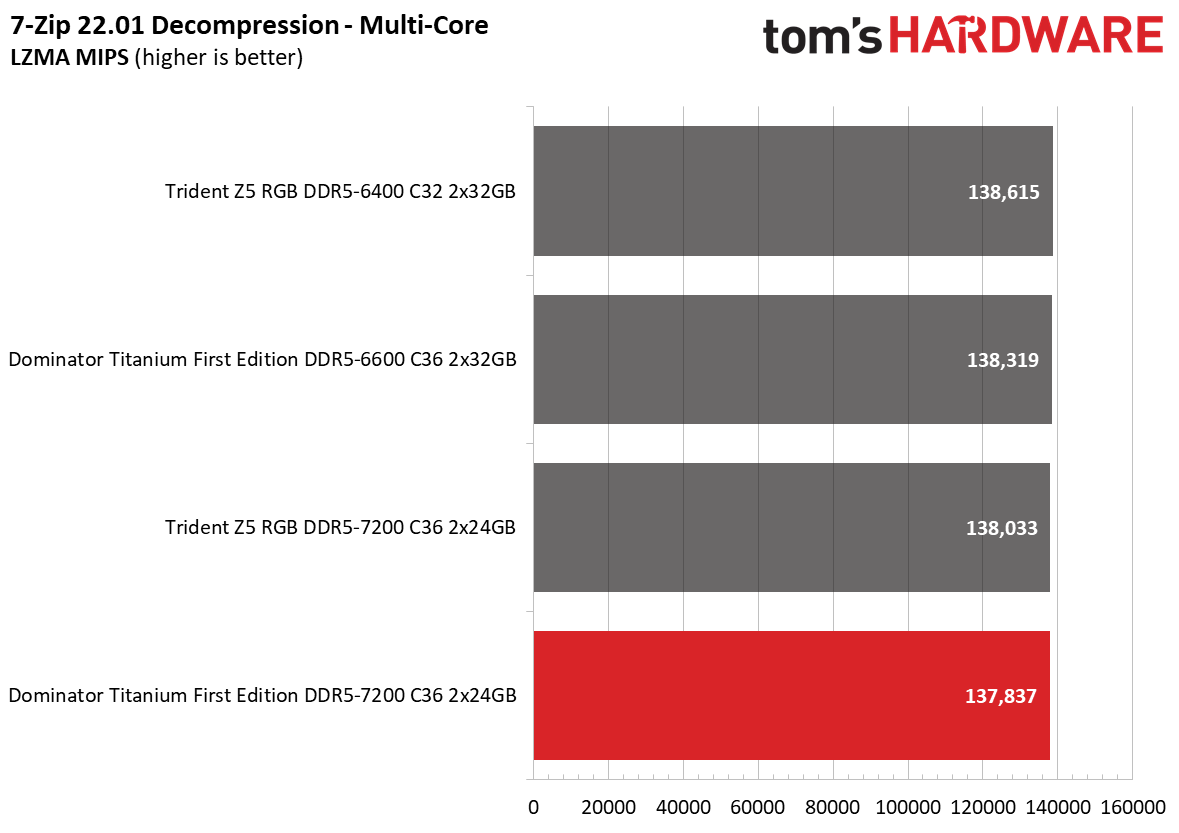
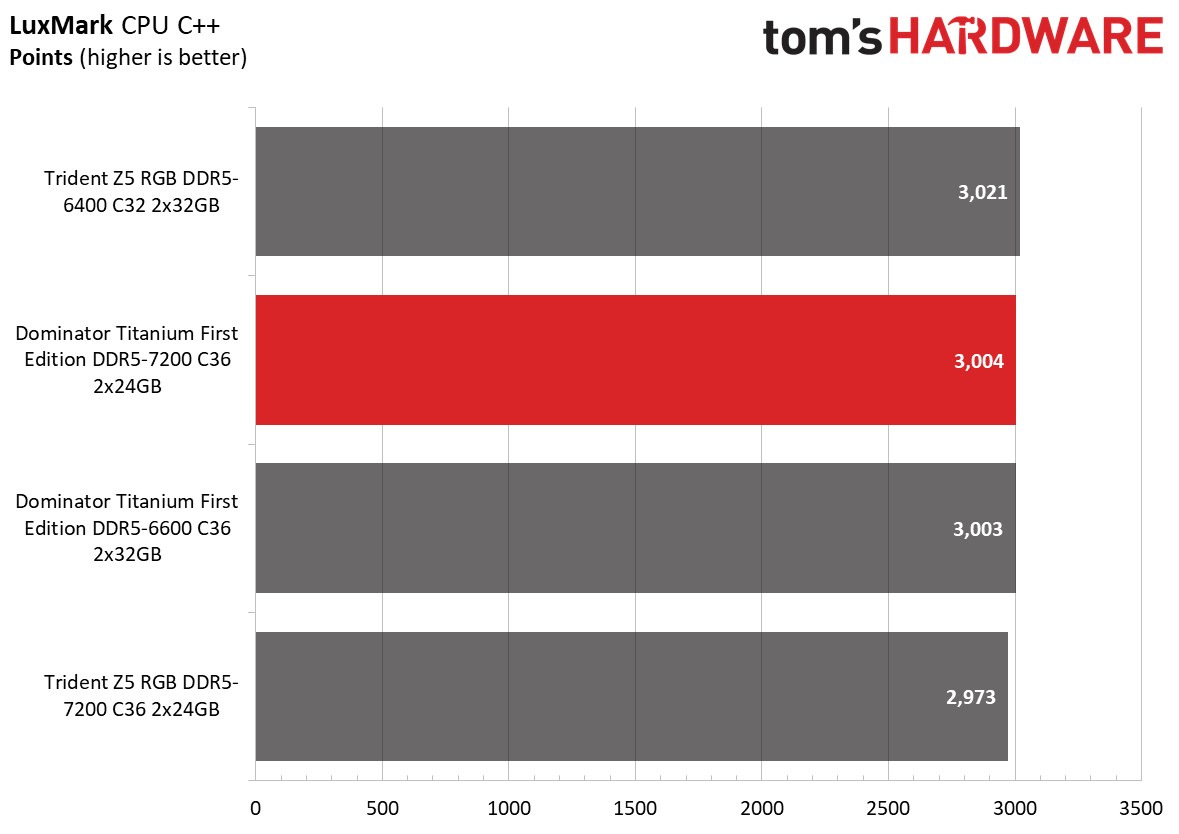
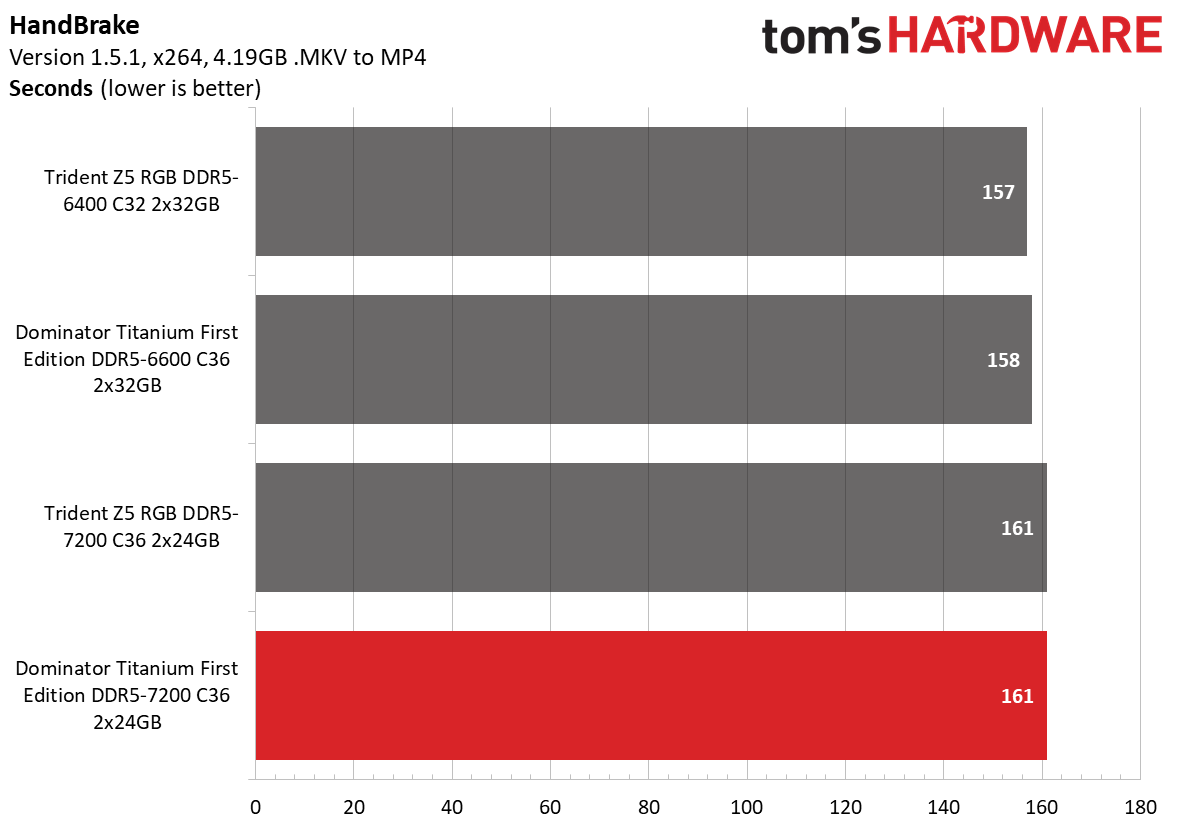
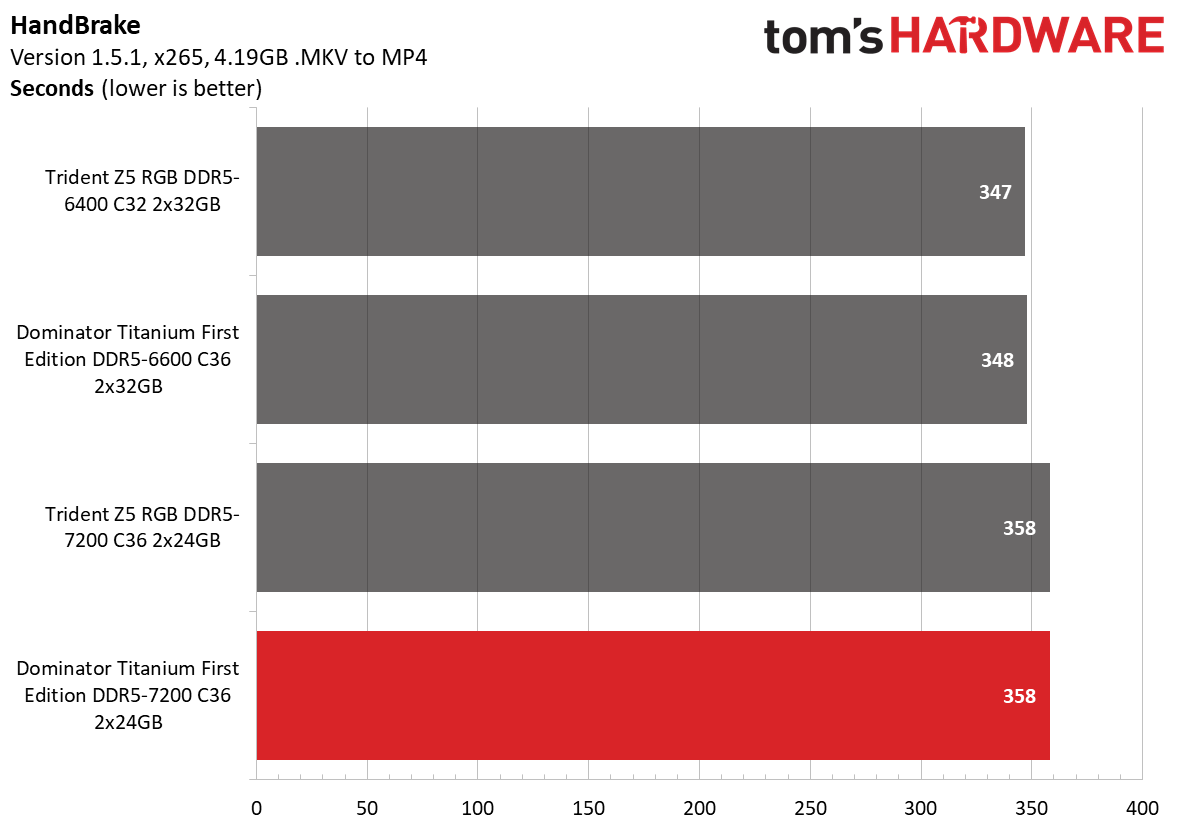
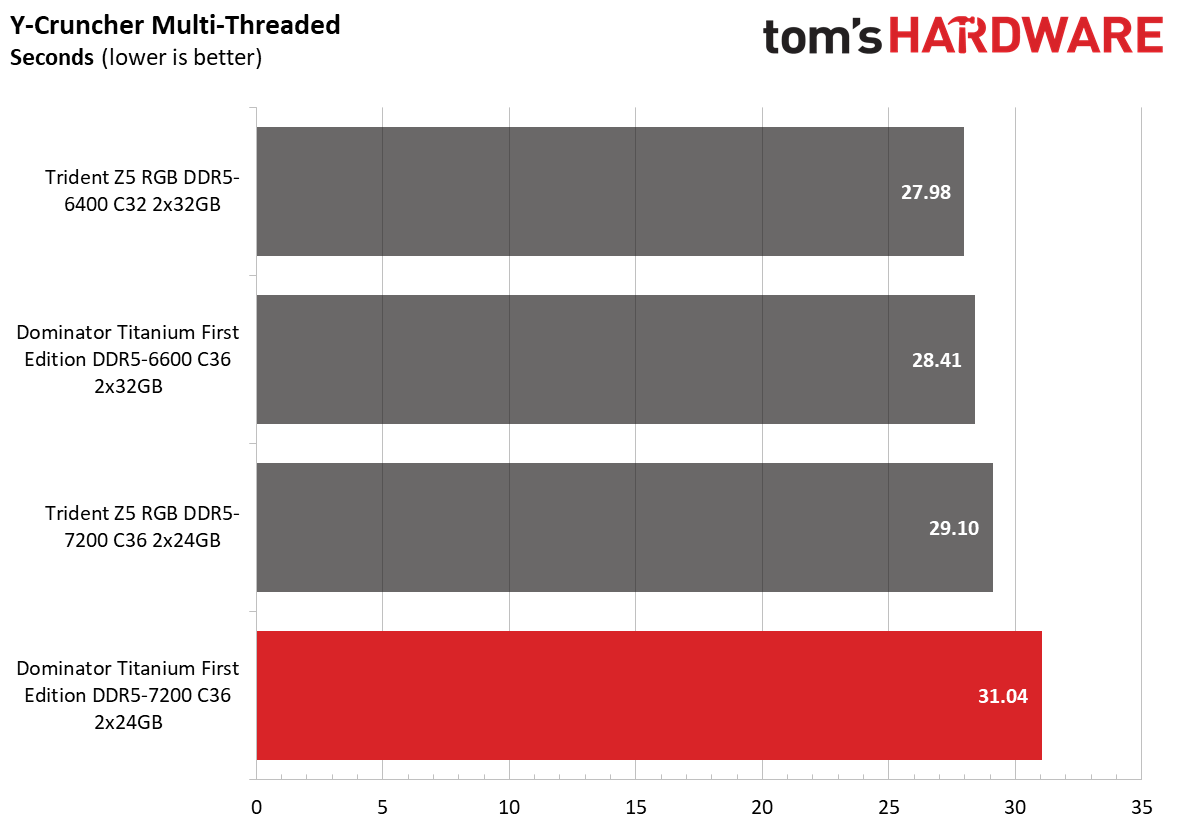
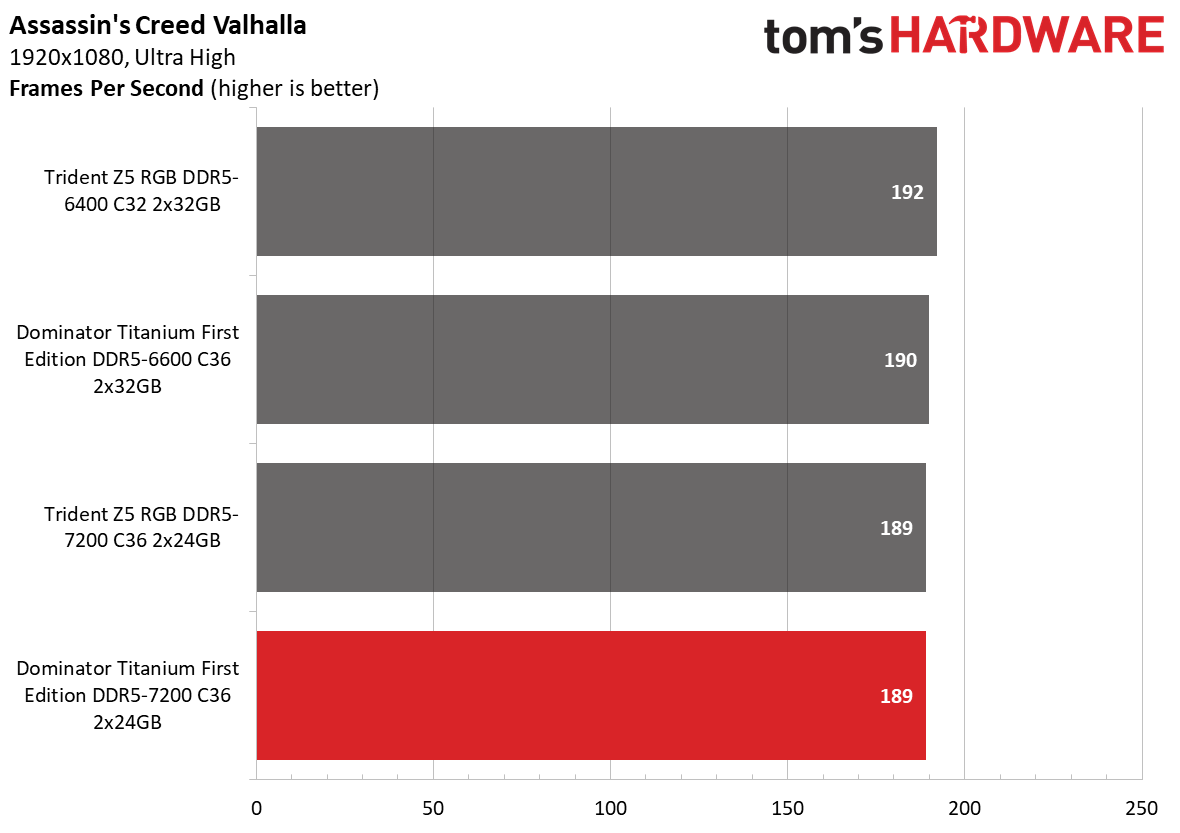
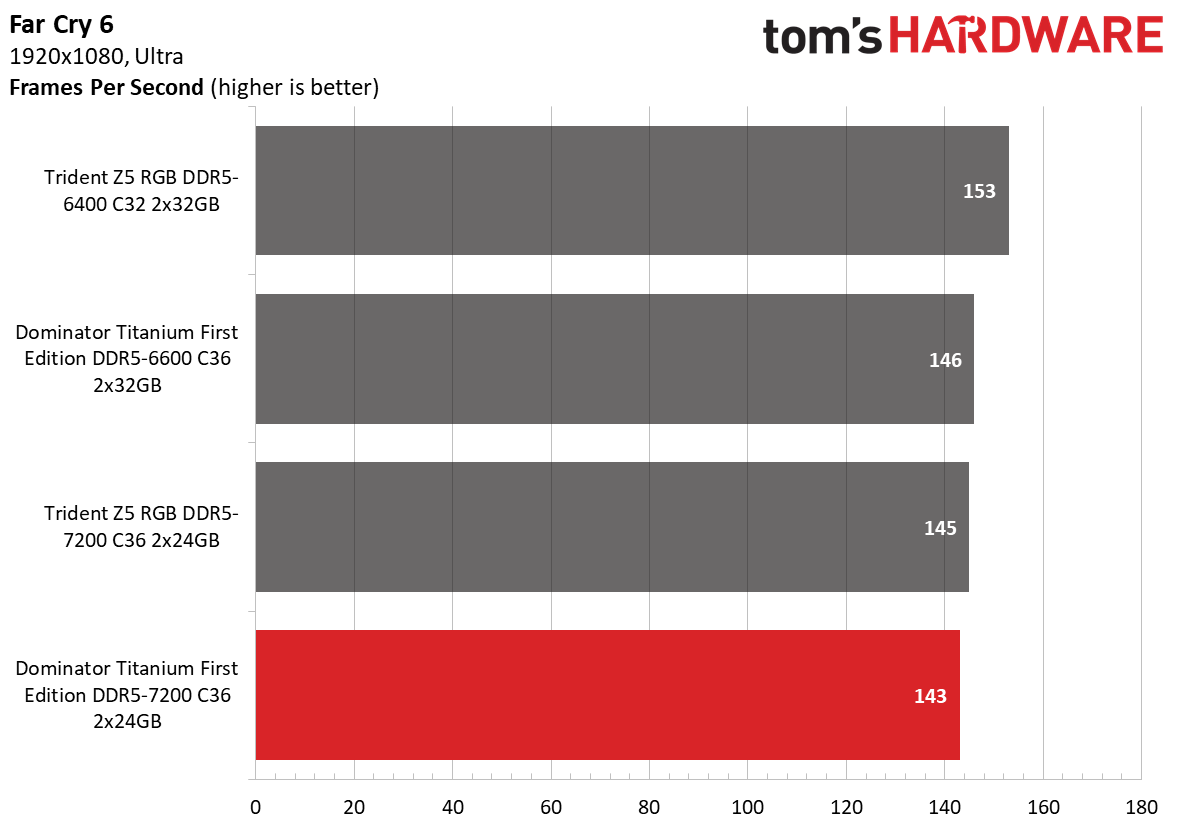
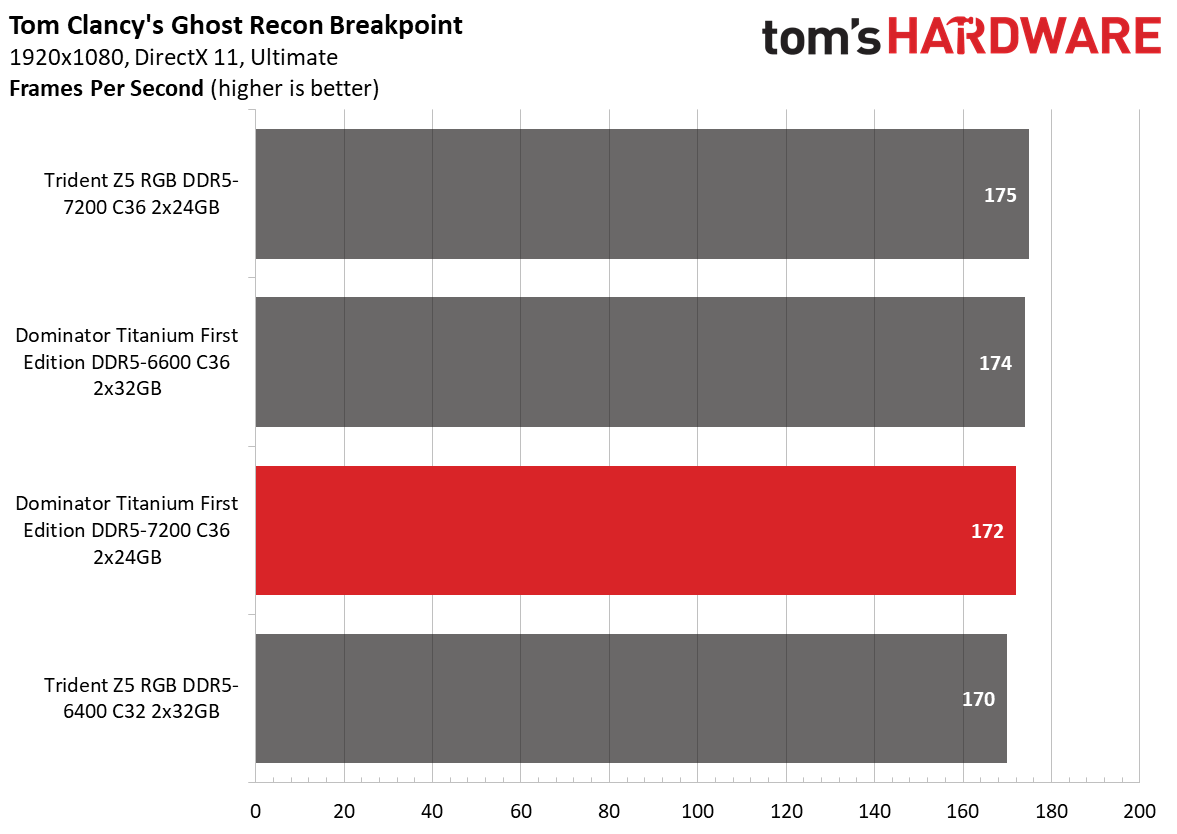
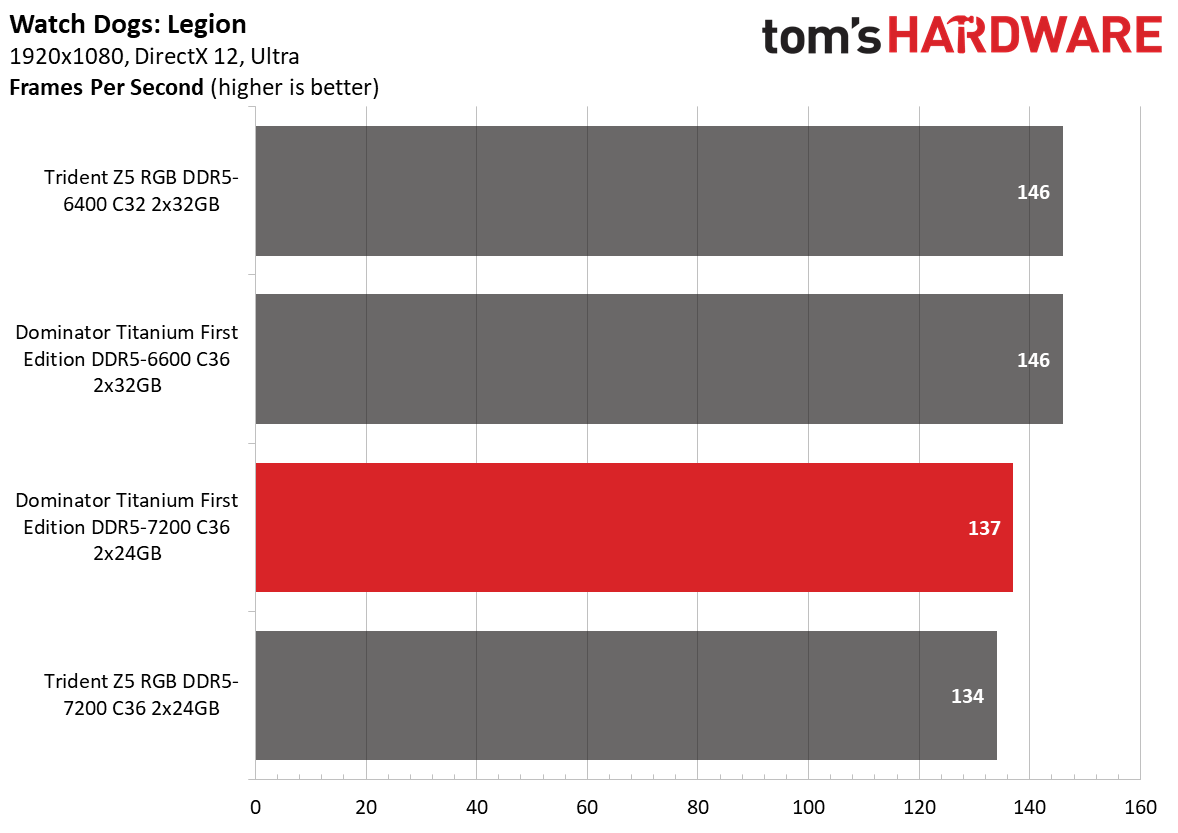
However, the memory kit delivered a different level of performance on the AMD platform, where it ranked last cumulatively. It gets outpaced by the rivaling Trident Z5 RGB DDR5-7200 C36 memory kit. However, the performance difference between the 48GB and 64GB memory kits was more marked on the AMD system.
Overclocking and Latency Tuning
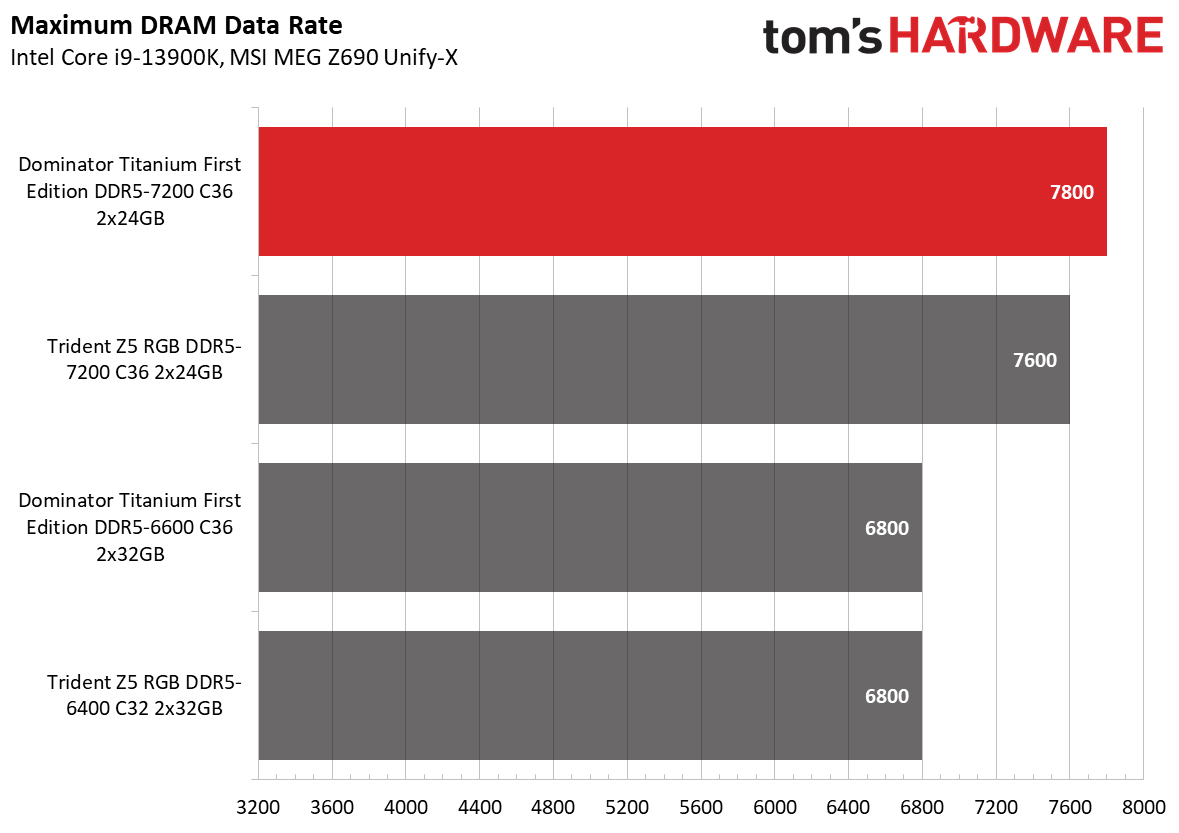
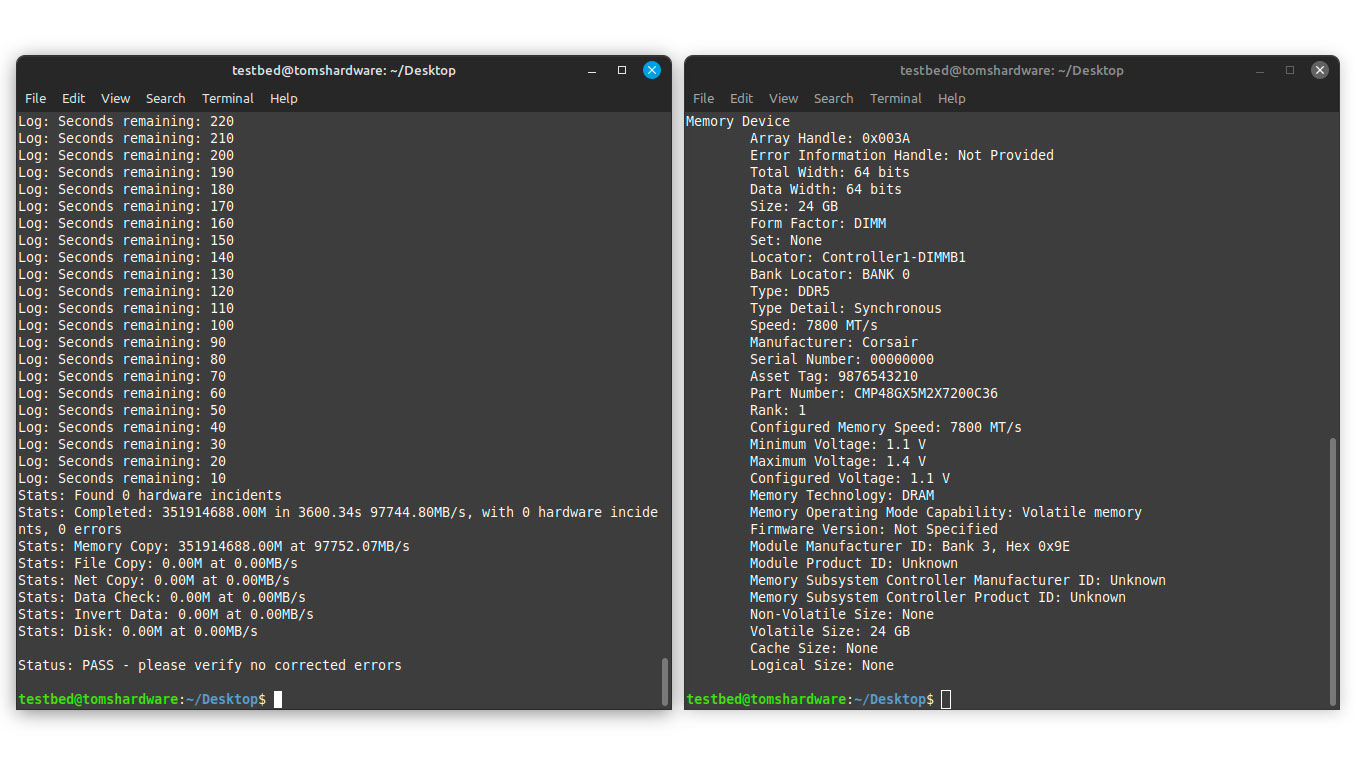
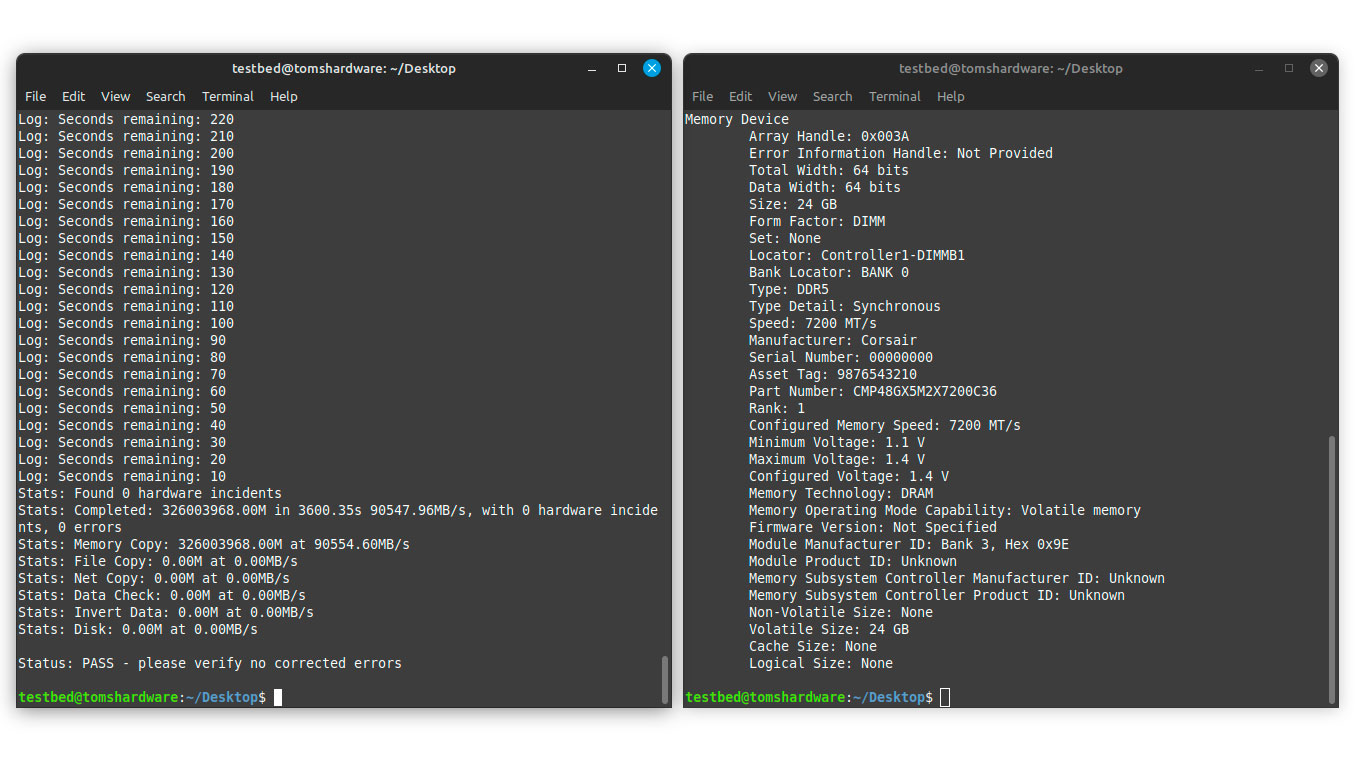
The overclocked XMP 3.0 profile on the Dominator Titanium uses 1.4V for DDR5-7400, similar to DDR5-7200. It was possible to maintain the same voltage because Corsair loosened the timings from 36-46-46-116 to 38-48-48-120. The M-die ICs have more headroom if you're enthusiastic enough to push a higher DRAM voltage. At 1.45V, the memory can not problem operating at DDR5-7800 with identical DDR5-7200 timings.
Lowest Stable Timings
| Memory Kit | DDR5-6400 (1.45V) | DDR5-6600 (1.45V) | DDR5-6800 (1.45V) | DDR5-7200 (1.45V) | DDR5-7600 (1.45V) | DDR5-7800 (1.45V) |
|---|---|---|---|---|---|---|
| Corsair Dominator Titanium First Edition DDR5-7200 C36 | N/A | N/A | N/A | 34-42-42-82 | N/A | 36-46-46-116 |
| G.Skill Trident Z5 RGB DDR5-7200 C36 | N/A | N/A | N/A | 34-42-42-84 | 36-46-46-115 | N/A |
| G.Skill Trident Z5 RGB DDR5-6400 C32 | 32-37-37-77 | N/A | 32-39-39-102 | N/A | N/A | N/A |
| Corsair Dominator Titanium First Edition DDR5-6600 C32 | N/A | 32-37-37-76 | 34-39-39-76 | N/A | N/A | N/A |
M-die ICs can only go so tight at specific data rates. That's why the Dominator Titanium and the analogous Trident Z5 RGB are stable with almost equal timings at DDR5-7200, with the DRAM voltage increasing to 1.45V. However, Corsair's memory kit overclocked higher, but that could be attributed to the silicon lottery.
Bottom Line
The Dominator Titanium First Edition DDR5-7200 C36 delivers on all fronts. The memory kit has a good capacity for intensive workloads, looks excellent while allowing some user customization, and provides top-level performance. The changeable top bar is a great idea, especially if it carries over to the new products so that you can swap and recycle the accessories. However, the accessory kits are expensive at $29.99 a piece unless you can access a 3D printer. The cost adds up if you're running four memory modules, as you'll spend nearly $60 on aesthetic accessories. Corsair only has one design available at the moment, so we would love to see the vendor offer more designs down the road.
The memory kit belongs to the premium category, and the price tag reflects that. Corsair sells the Dominator Titanium First Edition DDR5-7200 C36 for $284.99. Since it's a limited edition SKU, you won't find it anywhere else, so there won't be any price variation. The regular Dominator Titanium DDR5-7200 C36 retails for $264.99 if you love the RGB lighting. However, if you plan to pick up the fin-based top bar anyway, purchasing the First Edition will save you $9, and you receive some extra goodies like the screwdriver in the process.
- MORE: Best RAM
- MORE: DDR DRAM FAQs And Troubleshooting Guide
- MORE: All Memory Content

Zhiye Liu is a news editor, memory reviewer, and SSD tester at Tom’s Hardware. Although he loves everything that’s hardware, he has a soft spot for CPUs, GPUs, and RAM.
